Hanwha Techwin DIGIMAXL55W Digital Camera User Manual L55W en c V04
Samsung Techwin Co Ltd Digital Camera L55W en c V04
Contents
- 1. Users Manual 1 of 3
- 2. Users Manual 2 of 3
- 3. Users Manual 3 of 3
Users Manual 2 of 3
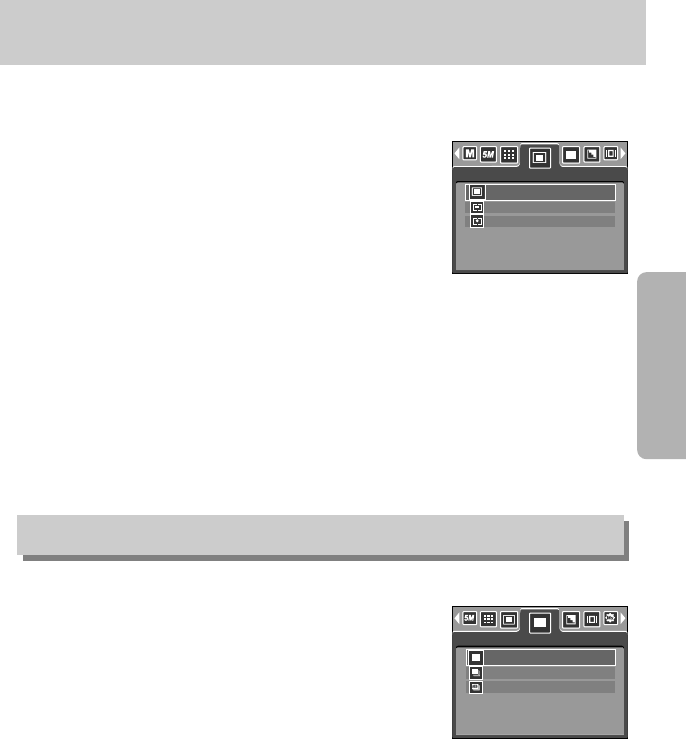
ŝ61Ş
ƈYou can select continuous shot, and AEB (Auto Exposure Bracketing).
- [SINGLE]: Take one picture only
- [CONTINUOUS]: Images will be taken continuously until the
shutter button is released. The shooting capacity depends on
the memory (Max : 4 shots).
- [AEB] : Take three pictures in a series in different exposures:
short exposure (-0.5EV), standard exposure (0.0EV) and
over exposure (+0.5EV). Use the mode if it is hard to decide
exposure of the object.
ſHigh resolution and picture quality increases file saving time, which increases stand-by
time.
ſIf the [CONTINOUS] or [AEB] sub menu is selected, the flash will be off automatically.
ſIf less than 3 pictures are available in the memory, the AEB shooting is not available.
ſIt is best to use a tripod for the AEB shooting as the time to save each image file is longer
and the blurring caused by camera shake may occur.
ſIf the [TIFF] quality is selected, the [CONTINUOUS] or [AEB] menu can’t be selected.
Metering
[ PROGRAM mode ]
ƈIf you cannot obtain suitable exposure conditions, you can change the metering method to
take brighter pictures.
[MULTI] : Exposure will be calculated based on an average
of the available light in the image area. However,
the calculation will be biased towards the centre of
the image area. This is suitable for general use.
[CENTER-WEIGHTED] : Exposure will be calculated based
on an average of the available light
in the image area. However, the
calculation will be biased towards
the centre of the image area. This
is suitable for taking a picture of small object like a flower or insects.
[SPOT] : Only the rectangular area in the centre of the LCD monitor will be metered for light.
This is suitable when the subject in the centre is exposed correctly, regardless of the
back lighting.
ſIf the subject is not the centre of the focus area, do not use the spot metering as this may
result in an exposure error. In this circumstance, It is better to use exposure compensation.
Continuous shot
[ PROGRAM mode ]
METERING
SINGLE
CONTINUOUS
AEB
SHOOTING
MULTI
CENTER-WEIGHTED
SPOT
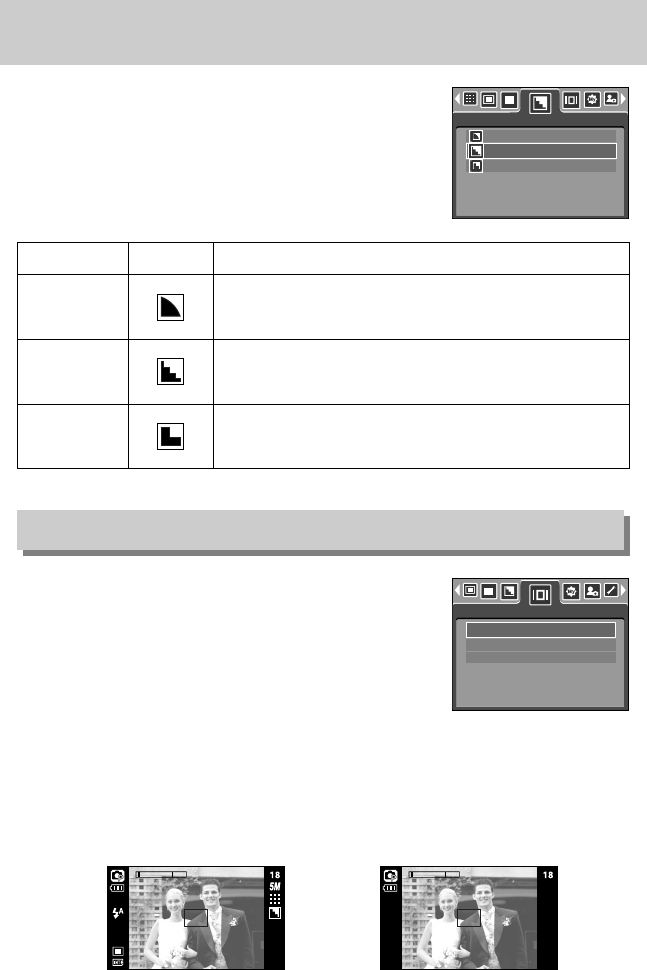
ŝ62Ş
Sharpness
OSD(On Screen Display) information
ƈYou can adjust the sharpness of the picture you want to take.
You cannot check the sharpness effect on the LCD monitor
before you take a picture, because this function is applied
only when the captured image is stored on the memory.
Sub menu Icon Description
The edges of the image are softened.
This effect is suitable for editing images on your PC.
The edges of the image are sharp.
This is suitable for printing.
The edges of the image are emphasized.The edges will appear
sharp, but noise may occur in the recorded image.
VIVID
NORMAL
SOFT
ƈIn any mode with the exception of VOICE RECORDING
mode, you can check the recording status in the LCD
monitor.
ƈIdle mode : If you select the [SAVE MODE] and the camera
isn't operated during the specified time(about
30 SEC.), the camera power will be idle (LCD
monitor : OFF, Camera status lamp : Blinking)
automatically.
- To use the camera again, press any of the camera buttons except the power button.
- If there is no operation during the specified time, the camera power will be turned off
automatically to save battery life. Refer to page 98 for more information about the auto
power off function.
FULL OSD
BASIC OSD
SAVE MODE
OSD INFORMATION
SOFT
NORMAL
VIVID
SHARPNESS
[Basic information mode]
[Full information mode]
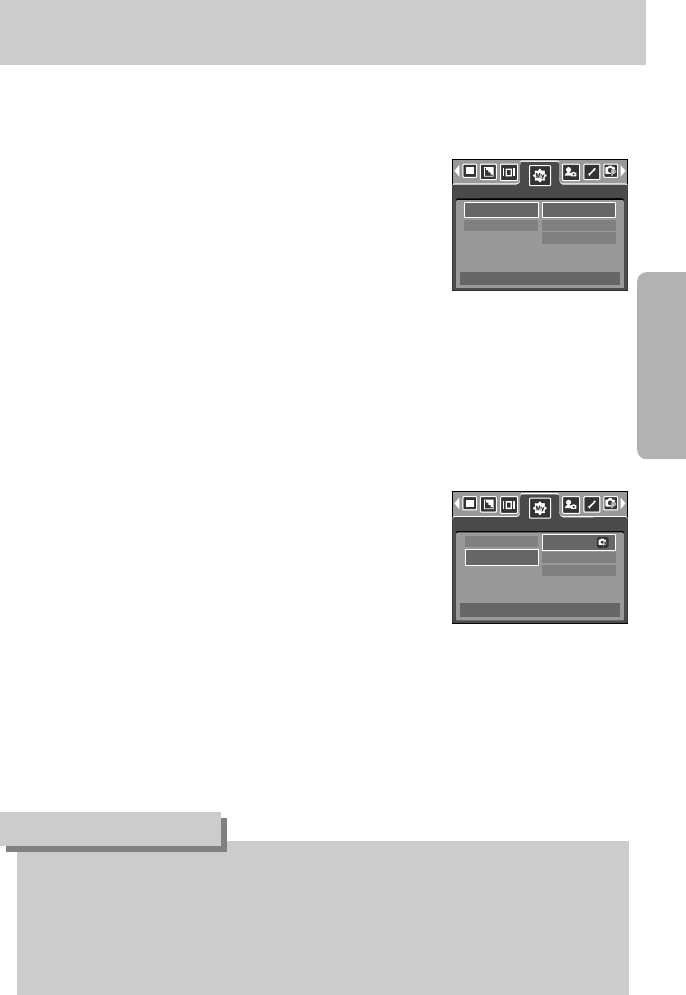
ŝ63Ş
Save / Load a specific camera configuration (MySET)
ƈUse the MySET mode to save frequently used camera settings (Save Myset) and use it later
(Load Myset)
ƃSaving the camera configuration :
1. Use the camera buttons and menu to set desired camera
configuration.
2. Select the Program mode and press the Menu button.
3. Press the Left/Right buttons to select the [MYSET] menu tap.
4. Select the [SAVE] menu by pressing the Up / Down button
and press the Right button.
5. Press the Up/Down buttons to select desired MySET slot
number to save.
6. Press the OK button to save the current configuration.
ƃLoading the saved camera configuration:
1. Select the Program mode and press the Menu button.
2. Press the Left/Right buttons to select the [MYSET] menu
tap.
3. Select the [LOAD] menu by pressing the Up / Down
button and press the Right button.
4. Press the Up/Down buttons to select desired MySET slot
number to load.
5. Press the OK button to set the camera configuration as
saved in the MySET slot.
* The current MySET slot number is displayed in the top left of the LCD.
ƃSaving is available for the following camera functions.
Functions using the camera buttons - Macro, flash, white balance, ISO, RGB, Exposure
value, Aperture value and Shutter speed.
Functions using the menu screen - Size, quality, metering, effect, sharpness and
continuous shot.
INFORMATION
[ PROGRAM mode ]
[ PROGRAM mode ]
MYSET
SAVE
LOAD
MYSET1
MYSET2
MYSET3
MYSET
SAVE
LOAD
MYSET1
MYSET2
MYSET3
BACK:SET:OK
BACK:SET:OK
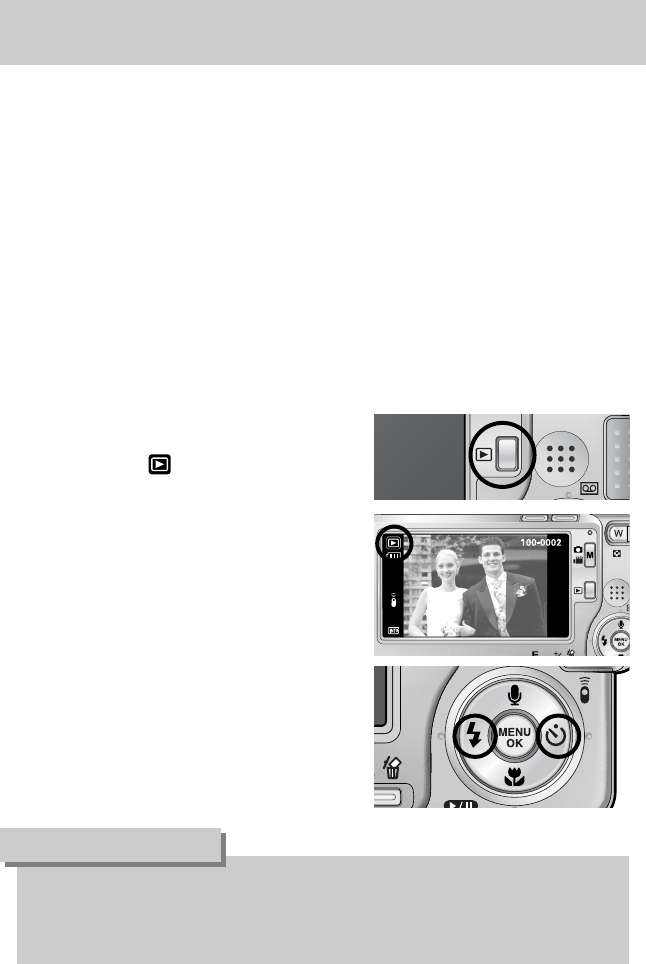
ŝ64Ş
Starting play mode
ƈIf the memory card is inserted in the camera, all the camera functions apply only to the
memory card.
ƈIf the memory card is not inserted in the camera, all the camera functions apply only to the
internal memory.
ƈIf you have turned on the camera by pressing the POWER button, you can press the PLAY
MODE button once to switch to Play mode and press it again to switch to Recording mode.
ƈYou can turn the power on with the play mode button. The camera is turned on in play mode.
Press the play mode button again and the camera will be turned off.
ƈYou can set up the PLAY mode function by using the camera buttons and LCD monitor.
3. Select an image that you want to play back by
pressing the LEFT/ RIGHT button.
ſPress and hold the Left or Right button to fast
forward the images played.
2. The last image stored on the memory is
displayed on the LCD monitor.
ƃPlaying back a still image
1. Select the PLAY mode by pressing the play
mode button ( ).
ƃManner mode : Pressing the play mode button for more than 3 seconds changes the
buzzer and start-up sound setting to OFF, even though you may have set these to ON.
ƃLightly press the shutter button in Play mode to switch to the currently set shooting mode.
INFORMATION
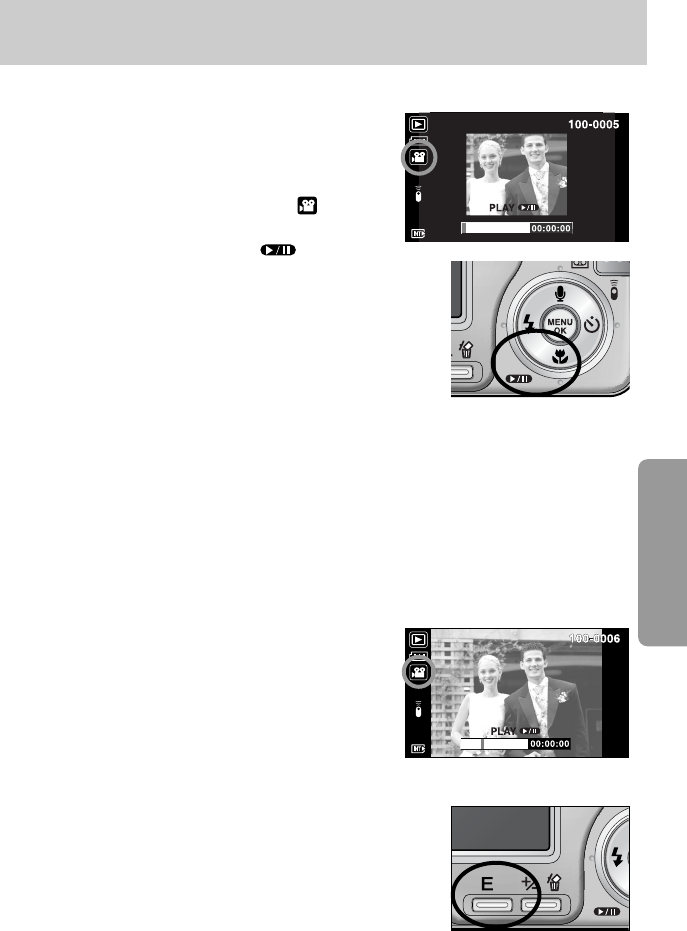
ŝ65Ş
Starting play mode
ƃPlaying back a movie clip
Steps from 1-2 are the same as those to play back a
still image.
3. Select the recorded movie clip that you want to play
back by using the LEFT/ RIGHT button. If you select
a movie clip, the movie clip indicator ( ) will be
displayed on the LCD monitor.
4. Press the play & pause button ( ) to play back
a movie clip file.
- To pause a movie clip file while playing it back,
press the play & pause button again.
- Pressing the play & pause button again will cause
the movie clip file will restart.
- To rewind the movie clip while it is playing, press the
LEFT button. To fast forward the movie clip, press
the RIGHT button.
- To stop playback of the movie clip, press the play & pause button, and then press the
LEFT or RIGHT button.
ƃHow to capture the movie clip
Steps 1-2 are the same as those for playing back a still
image.
3. Select the recorded movie clip that you want to play
back by using the LEFT/ RIGHT button.
4. Press the Play/ Pause button to play the movie clip
5. Press the Play/ Pause button while playing the movie
clip. Then press the E button.
6. The paused movie clip is saved in a new file name.
ſThe captured movie clip file has same size as the
original movie clip.
- Normal angle mode : 640X480, 320X240, 160X120
- Wide angle mode : 640X360, 384X216, 256X144
[Pressing the E button]
ƈMovie clip capture function : capture still images from the movie clip.
[Paused]
TRIM : T CAPTURE:E
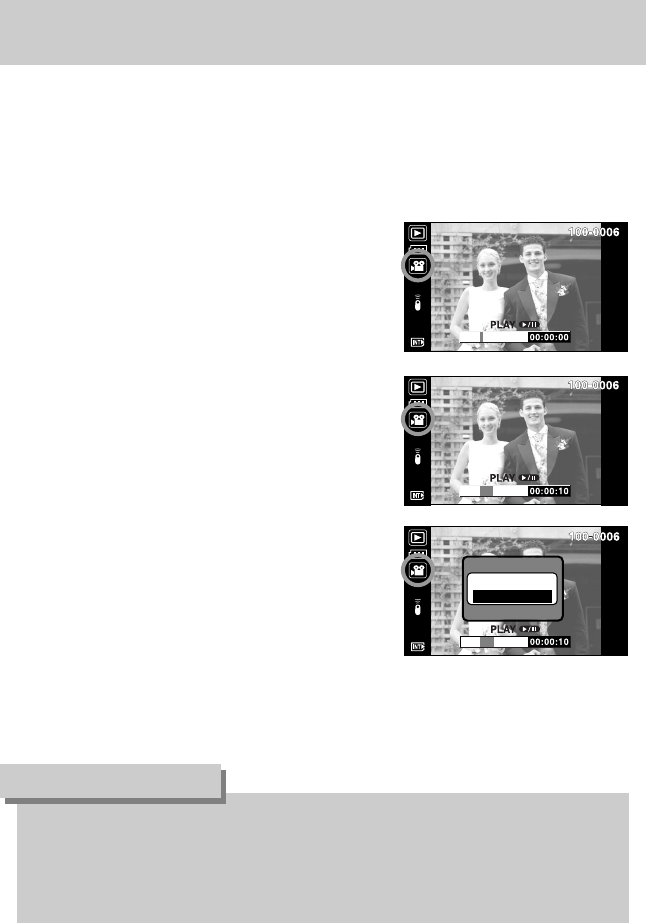
ŝ66Ş
Starting play mode
ƈOn camera movie trimming : You can extract desired frames of movie clip during the movie
clip play back.
1. Select a desired movie clip in the play mode.
2. Play back the movie clip by pressing the Play &
Pause button.
3. Press the Pause button at the point of the movie clip
that you want to start extracting.
4. Press the zoom T button.
5. Press the Play & Pause button and the extracted
range will be displayed on the status bar.
ƃIf the time line bar passes by the start point by pressing the REW(Left) button, the first
frame of the movie clip will display.
ƃIf you doesn’t specify the ending point of the movie clip, the trimming confirmation window
will display at the point of the last frame.
INFORMATION
TRIMMING?
TRIM
CANCEL
CONFIRM:OK
6. Press the Play & Pause button once more at the
point where you wish the extracted file to stop.
7. Press the zoom T button and a confirmation window
will display.
8. Select a desired sub menu by pressing the Up/
Down botton and press the OK button.
[TRIM] : the extracted file will be saved.
[CANCEL] : cancels the extracting movie clip
TRIM : T
TRIM : T CAPTURE:E
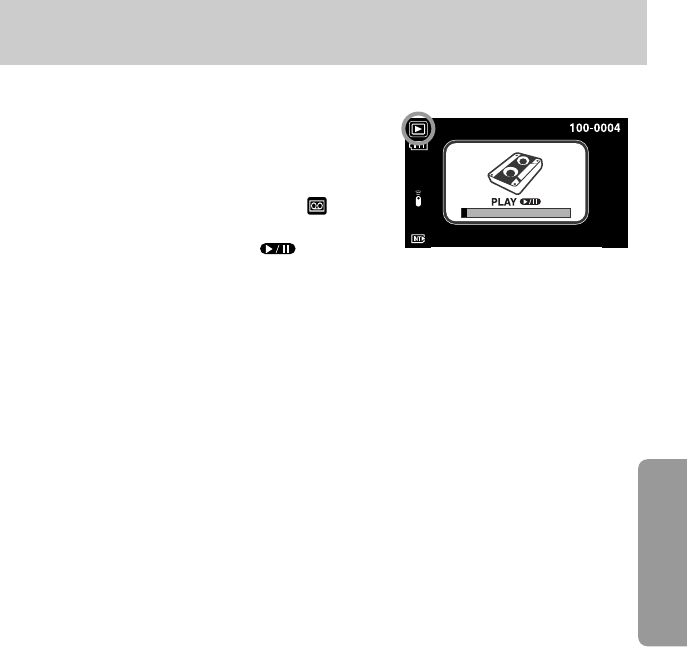
ŝ67Ş
Starting play mode
ƃPlaying back a recorded voice
Steps from 1-2 are the same as those to play back a
still image.
3. Select the recorded voice that you want to play back
by using the LEFT/ RIGHT button. If you select a
recorded voice file, the voice indicator ( ) will be
displayed on the LCD monitor.
4. Press the play & pause button ( ) to play back
a recorded voice file.
- To pause a recorded voice file, while playing it back, press the play & pause button again.
- To resume playback of the voice file, press the play & pause button.
- To rewind the voice file while it is playing, press the LEFT button.
To fast forward the voice file, press the RIGHT button.
- To stop playback of the voice file, press the play & pause button, and then press the
LEFT or RIGHT button.
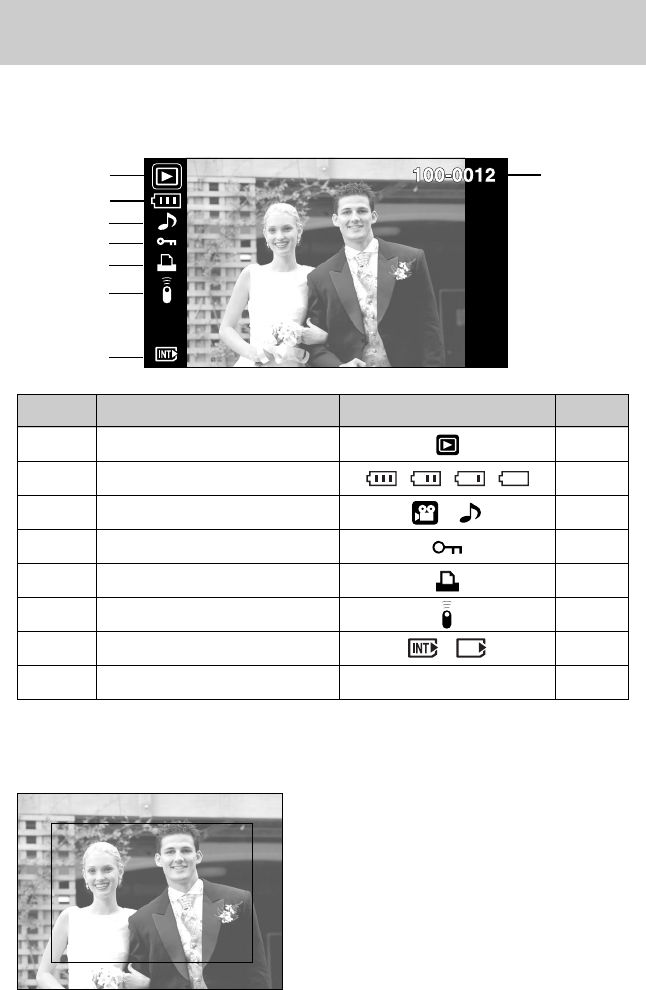
ŝ68Ş
LCD monitor indicator
ƈThe LCD monitor displays shooting information about the displayed image.
ƈSelect the [IMAGE INFORMATION] sub menu of the [OSD INFORMATION] menu and you
can check the recording information.
No. Description Icon Page
1
Play mode -
2 Battery
p.17
3 Movie clip / Voice memo -
4 Protect indicator p.85
5DPOF indicator p.86
6Remote control indicator -
7 Memory card indicator -
8
Folder name and Stored image number
100-0012 -
ۀ
ں
ڹ
ڻ
ڼ
ڽ
ھ
ڿ
SIZE : 2592X1944 Size
AV : F3.3 Aperture value
TV : 1/60 Shutter speed
ISO : 75 ISO sensitivity
FLASH
: OFF
Whether or not the flash is used
DATE : 2005/08/01 Recording date
SIZE : 2592X1944
AV : F3.3
TV : 1/60
ISO : 75
FLASH : OFF
DATE : 2005/08/01
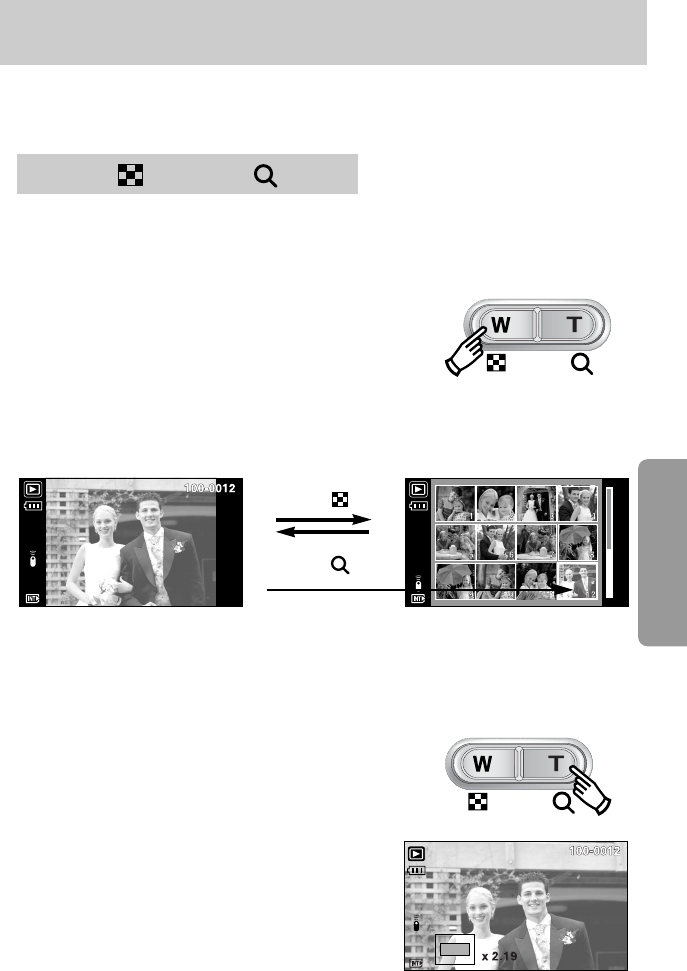
ŝ69Ş
Using the camera buttons to adjust the camera
ƈIn Play mode, you can use the buttons on the camera to conveniently set up the Play mode
functions.
ƃImage enlargement
1. Select an image that you want to enlarge and press the enlargement button.
2. Different parts of the image can be viewed by
pressing the 5 function button.
3. Pressing the thumbnail button will zoom back to the
original full sized image.
- You can tell whether the image displayed is an
enlarged view by checking the image enlargement
indicator shown at the bottom left of the LCD
monitor. (If the image is not an enlarged view, the
indicator will not be displayed.) You can also check
the area of enlargement.
- Movie clips and WAV files can’t be enlarged.
- If an image is enlarged, a loss of quality may occur.
Thumbnail( )/ Enlargement( ) button
[ Normal display mode ] [ Thumbnail display mode ]
Pressing the thumbnail
button( )
Pressing the enlargement
button( )
Highlighted image
ƃYou can view multiple pictures, enlarge a selected picture, and crop and save a selected area
of an image.
ƃThumbnail display
1. While an image is displayed full screen, press the
thumbnail button.
2. The thumbnail display will highlight the image that had
been showing at the time the thumbnail mode was
selected.
3. Press the 5 function button to move to a desired image.
4. To view an image separately, press the enlargement
button.
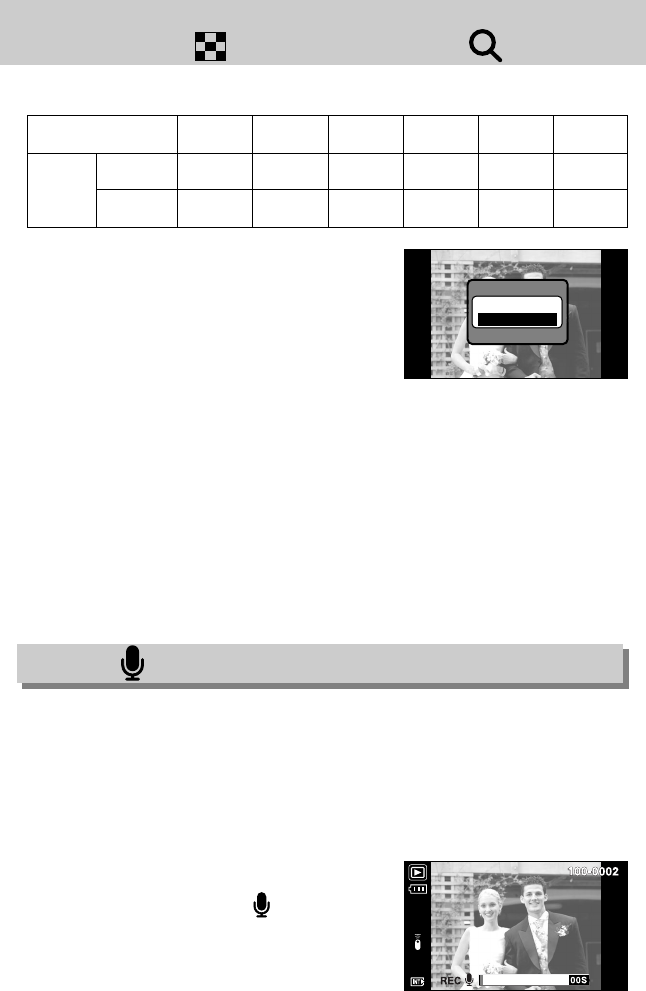
ŝ70Ş
Thumbnail( ) / Enlargement( ) button
ƃThe maximum enlargement rate in proportion to the image size.
ƃTrimming : You can extract part of the image that you
want and save it separately.
1. Select an image that you want to enlarge and press
the enlargement button.
2. Different parts of the image can be viewed by
pressing the 5 function button.
3. Press the MENU button and a message will be
displayed as shown alongside.
4. Select a desired sub menu by pressing the UP/ DOWN button and press the OK button.
[TRIM] : The trimmed image will save as a new file name, and display on the LCD
monitor.
[CANCEL]: The trimming menu will disappear.
ſIf there is little memory space to save the trimmed image, the image can’t be trimmed.
ſTo delete the enlarged image during the trimming function, press the delete button.
Image size 5M 4M 3M 2M 1M VGA
Normal angle
X9.0 X6.45 X5.3 X5.0 X4.0 X3.3
Wide angle
X4.6 X4.2 X3.6 X3.5 X2.5 X2.4
Maximum
enlargement
rate
Voice ( ) memo / Up button
ƈWhen the menu is displayed on the LCD monitor, pressing the UP button makes the menu
cursor move up.
ƈWhen the menu is not displayed on the LCD monitor, the UP button operates as the voice
memo button. You can add your voice to a stored still image.
ƃAdding a Voice Memo to a Still Image
1. Press the LEFT/ RIGHT button to select an image
that you wish to add sound to.
2. Press the voice memo button ( ) and the voice
memo indicator will display. The camera is now
ready to record a voice memo.
TRIMMING?
TRIM
CANCEL
CONFIRM:OK
START : SHUTTER
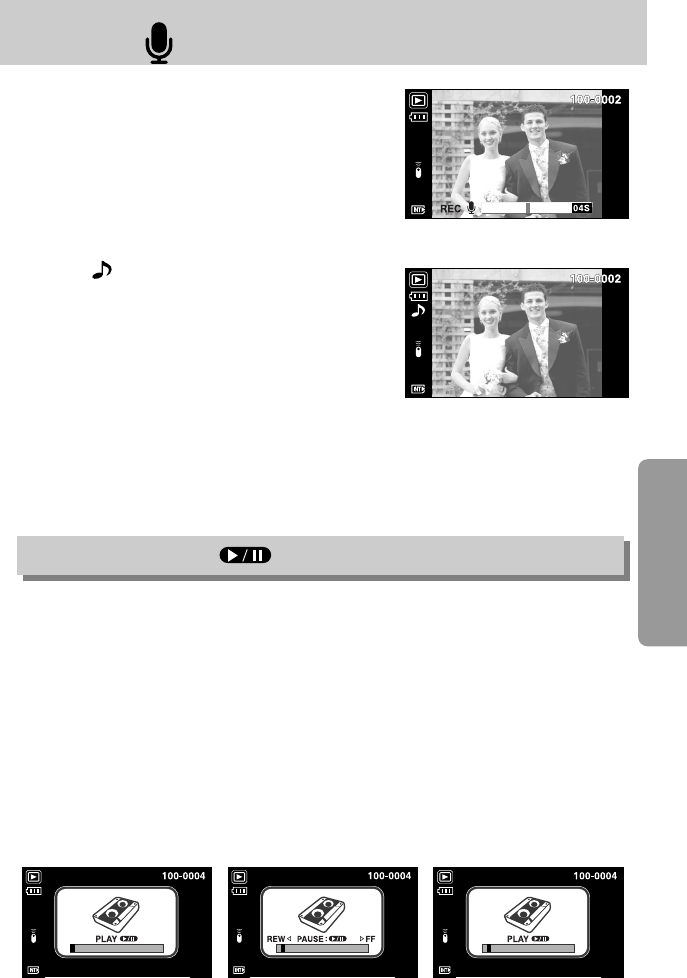
ŝ71Ş
Voice ( ) memo / Up button
3. Press the shutter button to start recording and voice
will be recorded to the still image for 10 seconds.
While the voice is recording, the recording status
window will be displayed as shown alongside.
4. The recording can be stopped by pressing
the shutter button again.
5. The ( ) icon will be displayed on the LCD monitor
after voice memo recording has finished.
- Voice memos can’t be recorded onto movie clip and
voice recording files.
- A distance of 40cm between you and the camera
(microphone) is the best distance to record sound.
- The voice memo will be saved in ҭ.wav format, but
has the same file name as the still image to which it
corresponds.
- If you add a new voice memo to the still image that already has a voice memo, the
existing voice memo will be erased.
Play & Pause ( ) / Down button
ƈIn Play mode, the play & pause/ down button works as follows:
- If the menu is displayed
Press the DOWN button to move from the main menu to a sub menu, or to move down the
sub menu cursor.
- If a still image with a voice memo, a voice file, or a movie clip is playing
In Stop mode : Plays a still image with a voice memo, a voice file, or a movie clip.
During playback : Temporarily stops playback.
In Pause mode : Resumes playback
[Voice recording is stopped] [Voice recording is paused]
[Voice recording is playing]
STOP : SHUTTER
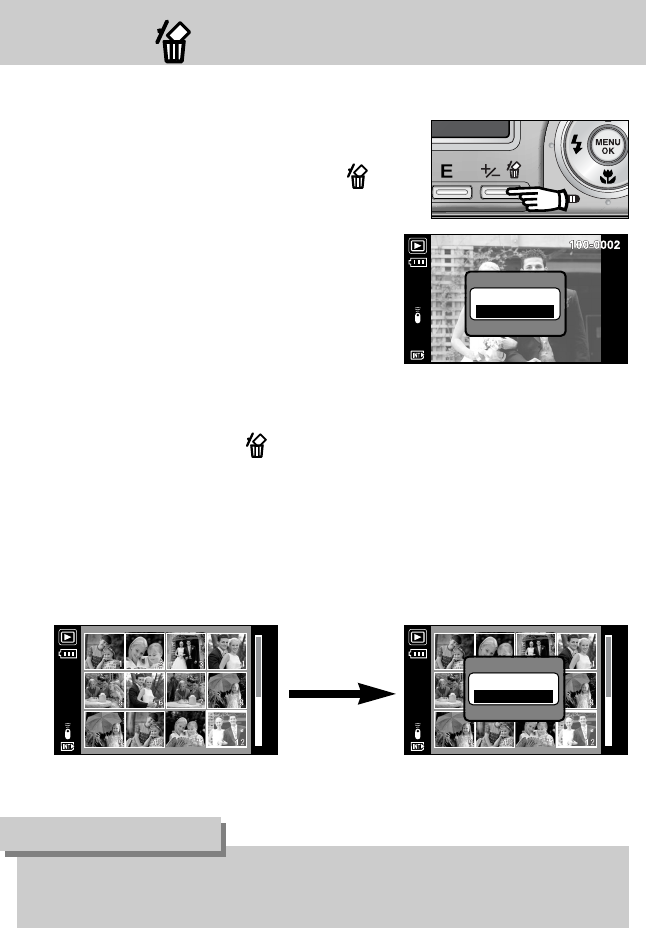
ƃBefore deleting images from the camera, you should protect or download images to your
computer that you wish to keep.
ŝ72Ş
Delete ( ) button
ƈThis deletes images stored on the memory.
INFORMATION
ƃDeleting Images in Thumbnail Display Mode
1. Use the UP, DOWN, LEFT, and RIGHT buttons to select the image you want to delete,
and then press the DELETE ( ) button.
2. The following message will be displayed on the LCD monitor.
3. Select the submenu values by pressing the UP/DOWN button and then press the OK
button.
If [DELETE] is selected : deletes the selected images.
If [CANCEL] is selected : cancels "Delete Image".
ƃDeleting Images in Play Mode
1. Select an image that you want to delete by pressing the
LEFT/ RIGHT button and press the DELETE( )
button.
2. A message will display as shown alongside on the
LCD monitor.
3. Select the submenu values by pressing the UP/
DOWN button and then press the OK button.
If [DELETE] is selected: deletes the selected images.
If [CANCEL] is selected : cancels "Delete Image".
Press the
delete button.
DELETE ?
DELETE
CANCEL
CONFIRM:OK
DELETE ?
DELETE
CANCEL
CONFIRM:OK
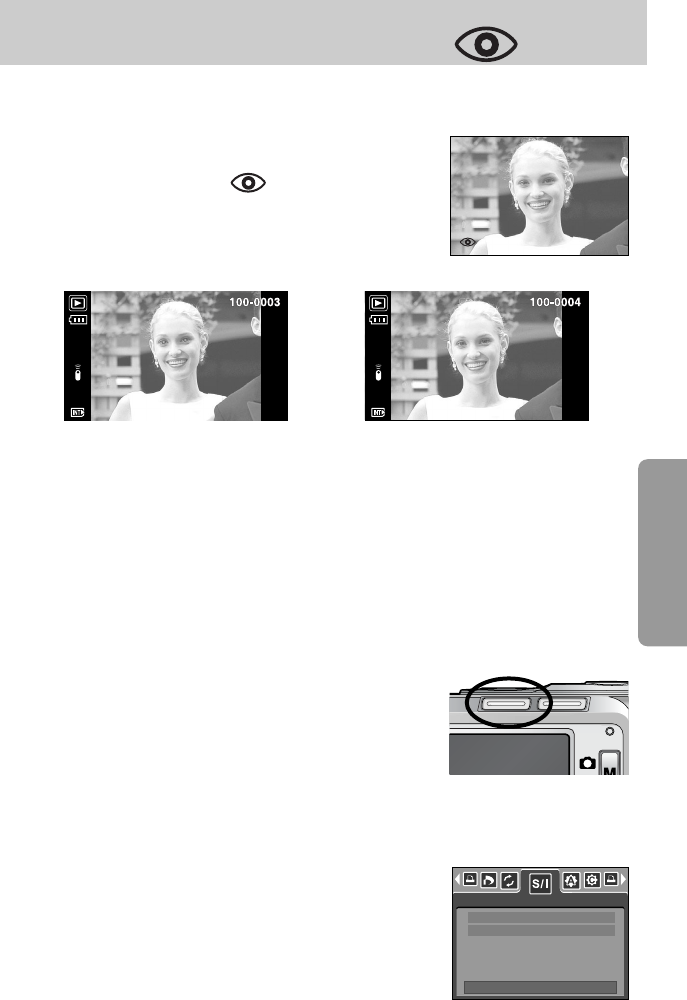
ŝ73Ş
ƈWhen an image that have Red-eye effect (When taking a people or animal with a
photographic flash, the eye will be red) plays back, this button will remove the red colour.
1. In the Play mode, select an image that has red-eye effect
by pressing the Left / Right button.
2. Press the Red eye button ( ) and a menu bar for
removing the red-eye effect will display.
3. Press the OK button and the part of red-eyed image will appear more natural looking.
Pressing the E button will cancel the menu.
ſThis function can’t be used with the TIFF file.
ſIf the image size is VGA, the red-eye effect may not be removed.
ſAccording to the shooting conditions, this function may not activate. But, this is not the
camera malfunction.
ƈIf you selected [COMPUTER] sub menu of [USB] setup
menu, when you connect the camera to your PictBridge
printer, the [CONNECTING COMPUTER] message will
display and the connection will not be established. In this
case, press the Printer button and the camera is connected to
the printer displaying the [CONNECTING PRINTER]
message. But, the camera may not connect to the printer and
turn off according to the printer manufacturer.
- After the connection, the Easy printing menu will display
on the LCD monitor. To display PictBridge menu, press
the Menu button. For more information about the
PictBridge menu, refer to page 91.
Red eye / Printer button ( )
[An image that has red-eye effect] [An image removed the red-eye effect]
IMAGES
ONE PIC
ALL PICS
SAVE:OK CANCEL:E
MOVE:

ŝ74Ş
Left / Right / Menu / OK button
ƈLEFT / RIGHT/ MENU/ OK buttons activate the following.
- LEFT button : While the menu is showing, press the LEFT button to select the menu tab
to the left of the cursor. While the menu is not showing, press the LEFT
button to select the previous image.
- RIGHT button : While the menu is showing, press the RIGHT button to select the menu
tab to the right of the cursor, or to move an secondary menu. While the
menu is not showing, press the RIGHT button to select the next image.
- MENU button : When you press the MENU button, the play mode menu will be displayed
on the LCD monitor. Pressing it again will return the LCD to the initial
display.
- OK button : When the menu is displayed on the LCD monitor, the OK button is used
for confirming data that is changed by using the 5 function button.
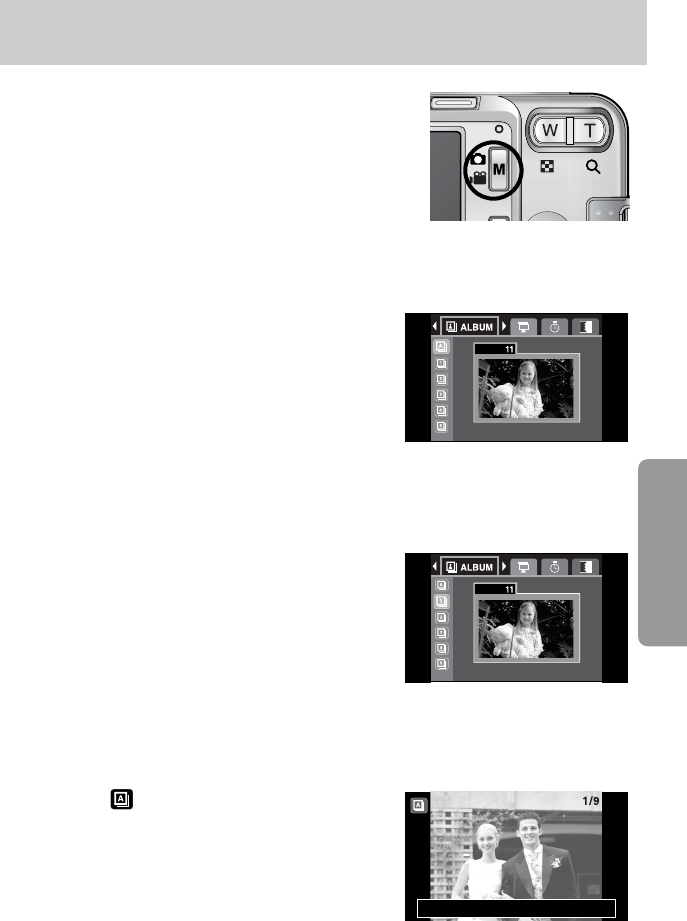
ŝ75Ş
Album button
ƈYou can organise the captured still images (except for the
TIFF file) into albums by using the Album button.
ƈThis camera has 8 albums and each album can take up to
100 images.
ƈThe album menu loading time depends on the memory
card type.
ƈHow to use the album
ƃSelecting the album
1. In the play mode, press the Album button.
2. Select the ALBUM menu by pressing the Left/ Right
button.
3. Select a desired album by pressing the Up/Down
button.
ƃInserting still images into the album
1. Select ( ) album.
2. Press the OK button and a window for inserting
images will display.
3. Up/ Down button: select an album for inserting
images
Left/ Right button: select images for inserting.
SELECT : OK
SELECT:OK EMPTY ALBUM:DEL
CONFIRM:OK E:EXIT
PREV ALBUM1 NEXT
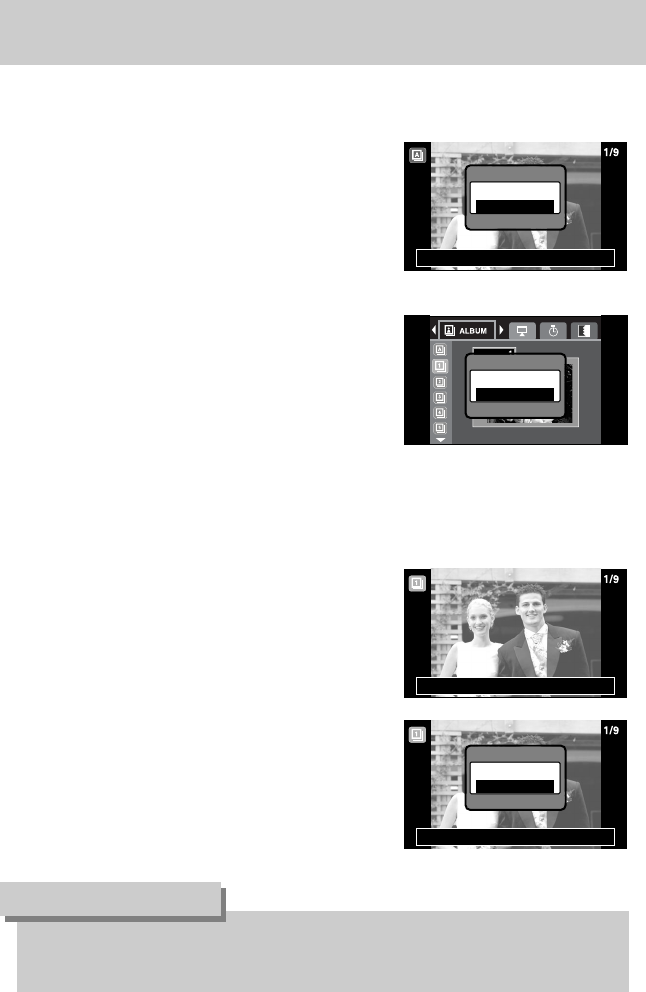
ŝ76Ş
Album button
4. Press the OK button and a confirmation window for inserting an
image will display. Select a desired sub menu by Pressing the
Up/Down button and press the OK button.
[YES] : inserts an image into the selected album.
[NO] : cancels the inserting image.
ƃRemoving still images from the album
1. Select an album.
2. Press the delete button and a confirmation window will
display.
3. Select a desired sub menu by pressing the Up/ Down
button and press the OK button.
[YES] : Removes all images in the album
[NO] : Cancels the removing images
ƃRemoving selected image
1. Select an album.
2. Press the OK button and a window for removing images will
display.
Left/ Right button: select images
Delete button : A confirmation window will display.
Select a desired sub menu by
pressing the Up/Down button and
press the OK button.
[YES] : the selected image will be removed
[NO] : Cancels the removing image
ƃIf an image is deleted from the memory, the image doesn’t display on an album.
ƃAn image can be added into the different albums.
INFORMATION
RELOCATE
YES
NO
CONFIRM:OK
SELECT:OK EMPTY ALBUM:DEL
EMPTY ALBUM?
YES
NO
CONFIRM:OK
PREV ALBUM1 NEXT
REMOVE
YES
NO
CONFIRM:OK
CONFIRM:OK E:EXIT
CONFIRM:OK E:EXIT
CONFIRM:OK E:EXIT
PREV ALBUM1 NEXT
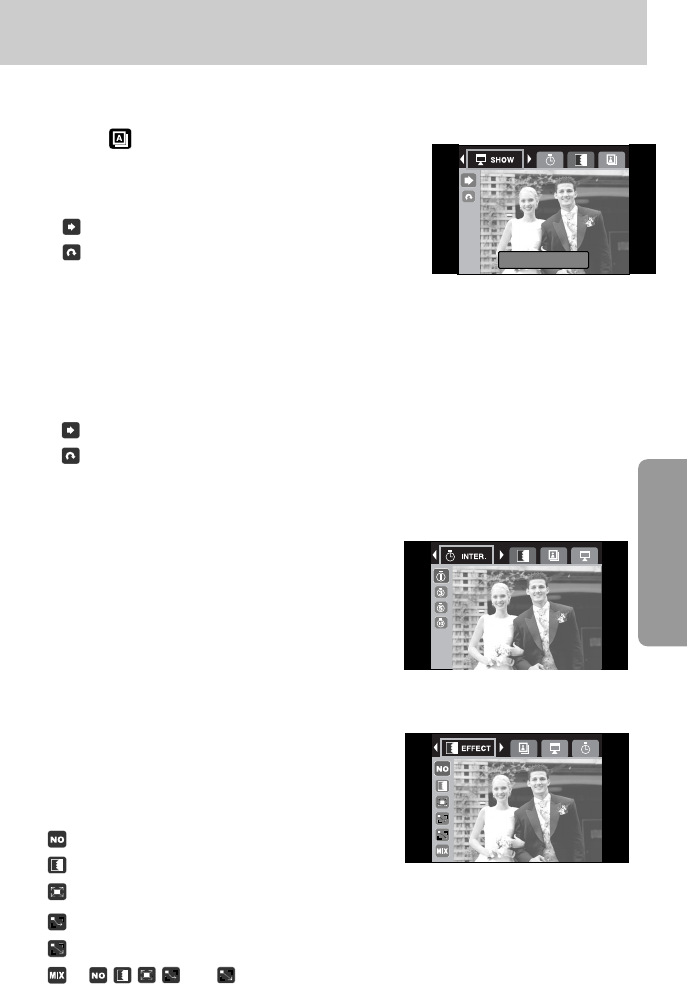
ŝ77Ş
Album button
ƃPlaying back the albums
ƄPlaying back all of the albums
1. Select ( ) album.
2. Select SHOW menu by pressing the Left/ Right button.
3. Select a desired sub menu by pressing the Up/ Down
button. Press the OK button and the slide show will start.
( ) : The slide show is closed after one cycle.
( ) : The slide show is repeated until the OK button is
pressed.
ƄPlaying a desired album
1. Select a desired album.
2. Select SHOW menu by pressing the Left/ Right button.
3. Select a desired sub menu by pressing the Up/ Down button.
Press the OK button and the slide show will start.
( ) : The slide show is closed after one cycle.
( ) : The slide show is repeated until the OK button is pressed.
ƃSetting play interval: Set the slide show play interval.
1. Select a desired album.
2. Select INTER. menu by pressing the Left/ Right
button.
3. Select a desired sub menu by pressing the
Up/ Down button.
ƃConfigure slide show effects
: Unique screen effects can be used for the slide show.
1. Select a desired album.
2. Select EFFECT menu by pressing the Left/ Right
button.
3. Select a desired sub menu by pressing the
Up/ Down button.
( ) : Normal display.
( ) : Image shows slowly.
( ) : Image is displayed slowly from the centre outwards.
( ) : Image moves from the top left.
( ) : The image slides diagonally from top left to bottom right.
( ) : and effects are applied in order.
PLAY:OK
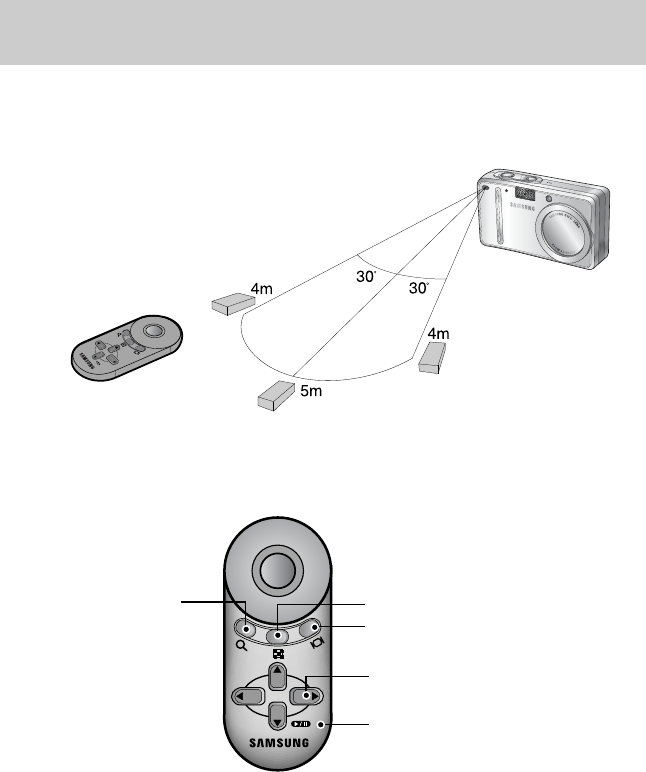
ŝ78Ş
ƈAfter connecting the camera with an external monitor, you can see the captured image by
using the remote control.
ƈRemote control is optional in some countries.
ƈIn play mode, you can use the remote control to set up the play mode functions.
Enlargement button Thumbnail button
Display / Information button
Up / Down / Left / Right button
Play & Pause button
ƈSee below for operation of buttons
- Enlargement button : In play mode, this button enlarges the selected image.
- Thumbnail button : If an image is enlarged, pressing this button will reduce the enlargement
rate. In play mode, you can view multiple pictures by pressing this button.
Remote control

ŝ79Ş
- Display / Information button : In play mode, you can view the information of the selected
image by pressing this button.
- Up / Down/ Left / Right button : In play mode, you can select a still image or movie clip by
pressing the Left/ Right button.
In play mode, different parts of the enlarged image can be
viewed by pressing these buttons.
In the thumbnail mode, you can move to a desired image
by pressing these buttons.
- Play & Pause button : If a still image with a voice memo or a movie clip is playing, pressing
this button make the files play back or pause.
Remote control
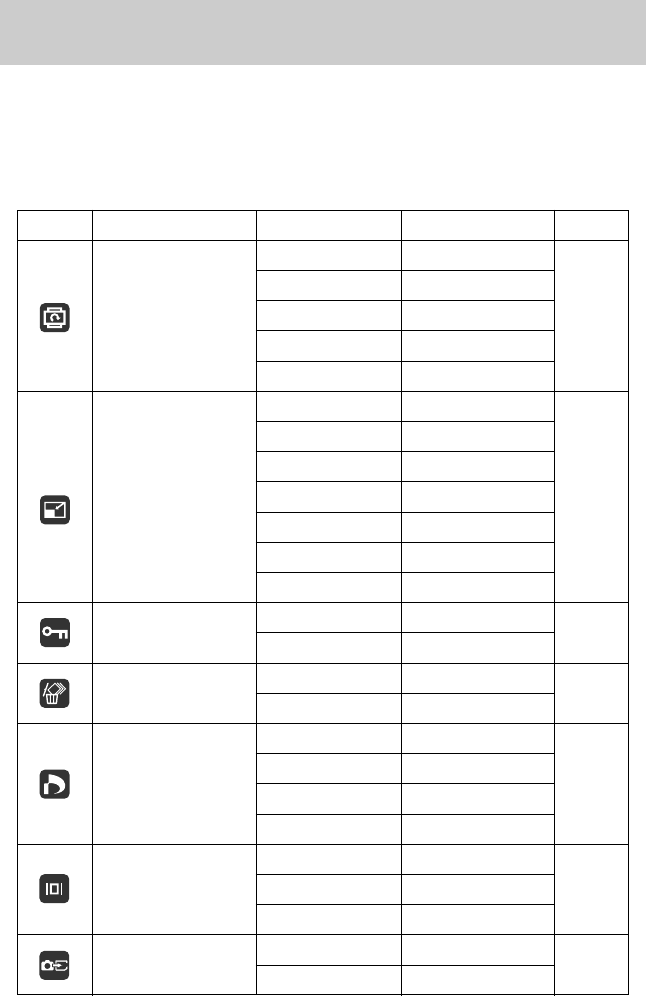
ŝ80Ş
Setting up the play back function using the LCD monitor
ƈPLAY mode functions can be changed by using the LCD monitor. In the PLAY mode,
pressing the MENU button displays the menu on the LCD monitor. The menus you can set up
in Play mode are as follows. To capture an image after setting up the play menu, press the
PLAY button.
Menu tab Main menu Sub menu Secondary menu Page
-
-
-
-
-
Normal angle mode Wide angle mode
2688X1512
2304X1296
1792X1008
1280X720
768X432
USER IMAGE1,2
-
-
-
-
-
-
ROTATE p. 83
RIGHT90Ŋ
LEFT90Ŋ
180Ŋ
HORIZONTAL
VERTICAL
DELETE ALL p. 86
NO
YES
COPY TO CARD
OSD INFORMATION
p. 90
p. 89
NO
YES
FULL OSD
BASIC OSD
IMAGE INFORMATION
DPOF
STANDARD
INDEX
PRINT SIZE
CANCEL
ONE PIC/ALL PICS
NO/ YES
DEFAULT/3X5/4X6/5X7/8X10
STANDARD/INDEX/PRINT SIZE
p. 86
PROTECT p. 85
SELECT
ALL
UNLOCK/LOCK
UNLOCK/LOCK
RESIZE p. 84
2272X1704
2048X1536
1600X1200
1024X768
640X480
USER IMAGE1,2
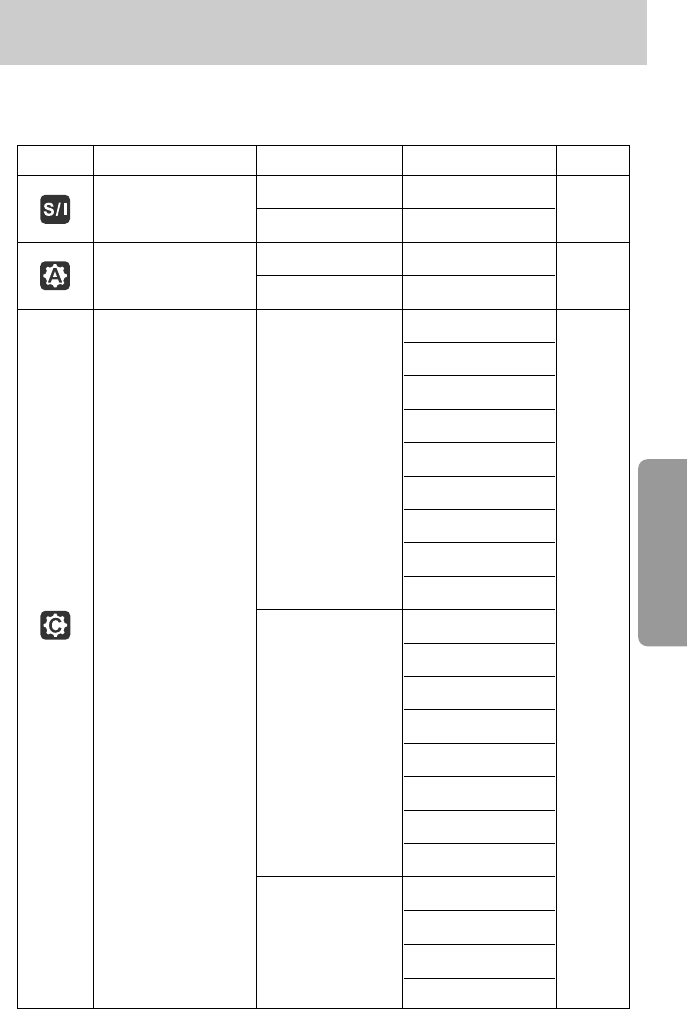
ŝ81Ş
Setting up the play back function using the LCD monitor
Menu tab Main menu Sub menu Secondary menu Page
-
-
-
-
AUTO
POSTCARD
CARD
LETTER
4 X 6
L
2L
A4
A3
AUTO
FULL
1
2
4
8
9
16
AUTO
PLAIN
PHOTO
FAST PHO.
CUSTOM SET p. 93
SIZE
LAYOUT
ONE PIC
ALL PICS
ƈThis menu is available while the camera is connected to a PictBridge supporting printer (direct
connection to the camera, sold separately) with a USB cable.
AUTO SET p. 93
NO
YES
IMAGES p. 92
TYPE
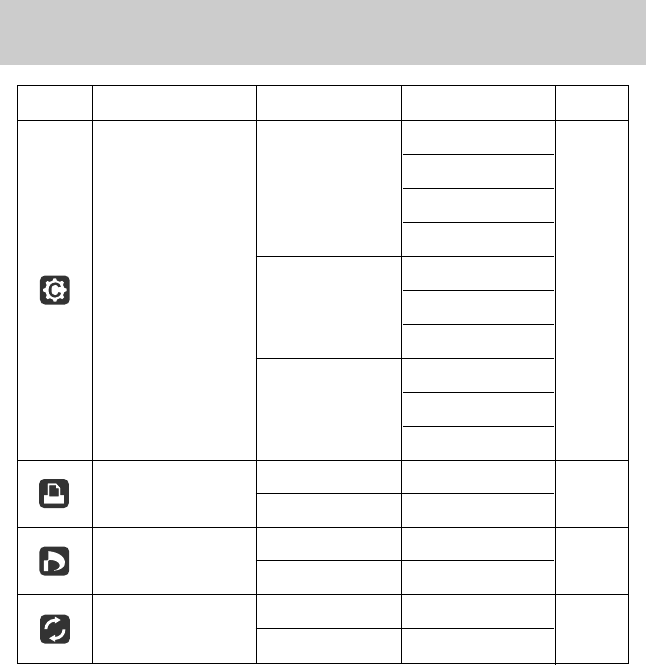
ŝ82Ş
Setting up the play back function using the LCD monitor
Menu tab Main menu Sub menu Secondary menu Page
AUTO
DRAFT
NORMAL
FINE
AUTO
OFF
ON
AUTO
OFF
ON
STANDARD -
INDEX -
-
-
-
-
CUSTOM SET
p. 95
p. 93
RESET
ſMenus are subject to change without prior notice.
QUALITY
DATE
FILE NAME
p. 94
NO
YES
NO
YES
p. 94
DPOF PRINT
PRINT
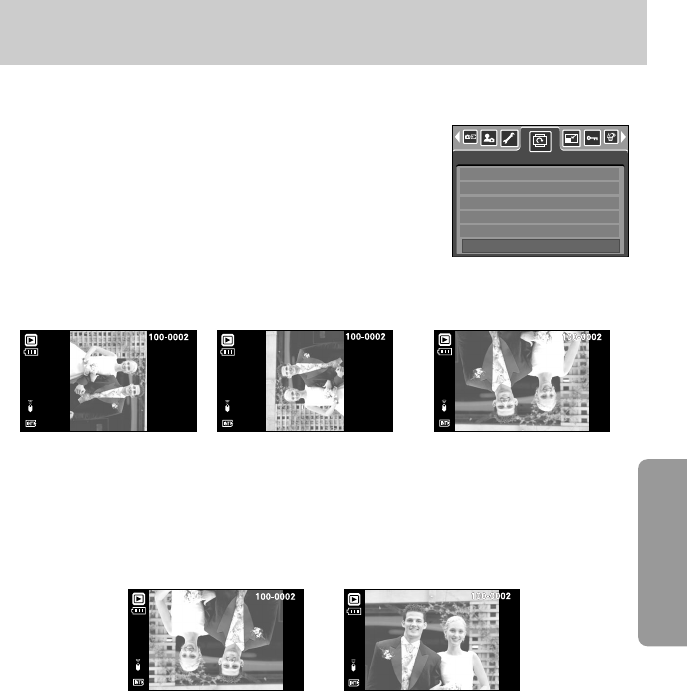
ŝ83Ş
Rotating an image
ƈYou can rotate the stored images by various degrees. Once the playback of the rotated
picture is finished, it will switch back to the original state.
1. Press the play mode button and press the menu button.
2. Press the LEFT/ RIGHT button and select the [ROTATE]
menu tab.
3. Select a desired sub menu by pressing the UP/ DOWN
button.
[RIGHT 90˚] :
Rotate picture in a
clock-wise direction
[LEFT 90˚] :
Rotate picture in a counter-
clock-wise direction
[180˚] :
Rotate picture 180 degrees
4. Press the OK button and the rotated image will be displayed.
If you display the rotated image on the LCD monitor, empty spaces may appear to the left
and right of the image.
[HORIZONTAL] :
Rotate picture horizontally
[VERTICAL] :
Rotate picture vertically
ROTATE
RIGHT 90ŭ
LEFT 90ŭ
180ŭ
HORIZONTAL
VERTICAL
EXIT:MENU MOVE:
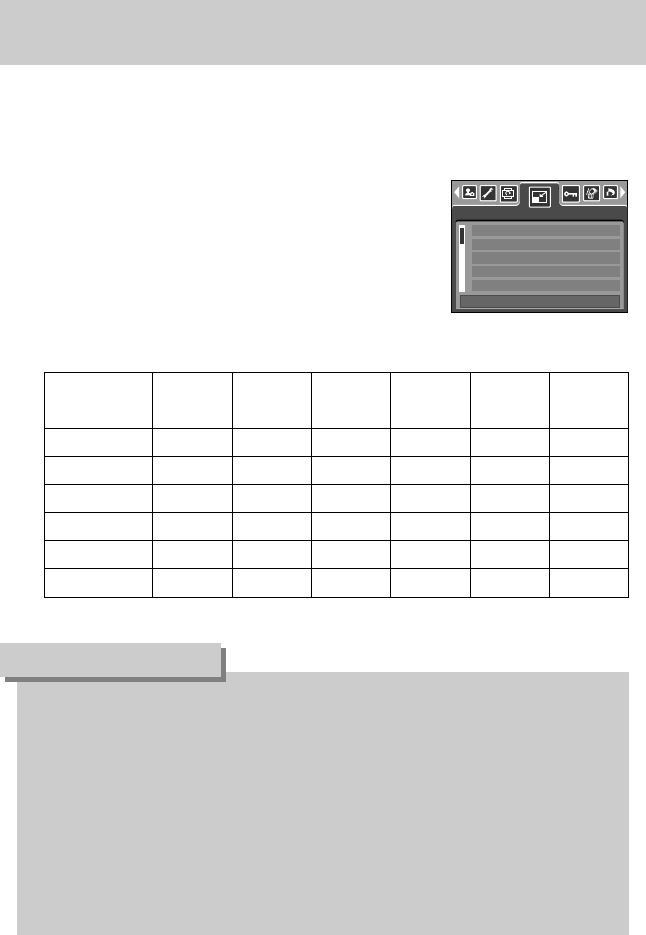
ŝ84Ş
Resize
ƈChange the resolution (size) of pictures taken. Select [USER IMAGE] to save an image to be
the start-up image. The resized image will have a new file name.
1. Press the play mode button and press the menu button.
2. Press the LEFT/ RIGHT button and select the [RESIZE]
menu tab.
3. Select a desired sub menu by pressing the UP/ DOWN
button and press the OK button.
ƃA large sized image can be resized to a smaller sized image, but not vice versa.
ƃOnly JPG images can be resized. MP4 (MOVIE), WAV (VOICE) and TIFF files can’t be
resized.
ƃYou can change the resolution of only those files compressed in the JPEG 4:2:2 format.
ƃThe resized image will have a new file name. The [USER IMAGE] image is stored not on
the memory card but on the internal memory.
ƃOnly two [USER IMAGE] images can be saved. If you save a new [USER IMAGE] image,
the existing startup image will be deleted in order.
ƃIf the memory capacity is insufficient to store the resized image, a [CARD FULL!]
message will display on the LCD monitor and the resized image will not be stored.
INFORMATION
5M O O OOOO
4M X O OOOO
3M X X OOOO
2M X X X O O O
1M X X X X O O
VGA X X X X X O
ƃImage Resize Types
Resize 4M
3M 2M 1M VGA
USER
IMAGE
RESIZE
2272 X 1704
2048 X 1538
1600 X 1200
1024 X 768
640 X 480
EXIT:MENU MOVE:
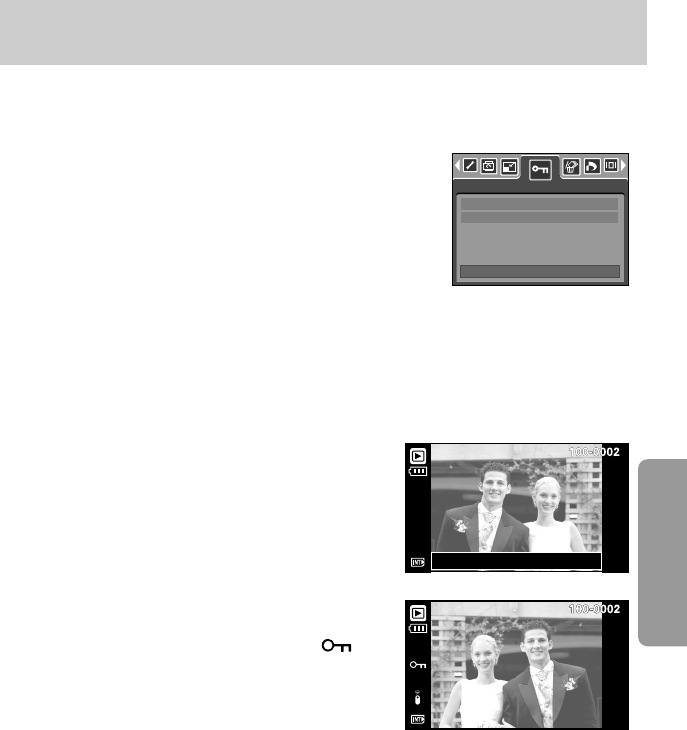
ŝ85Ş
Protecting images
ƈThis is used to protect specific shots from being accidentally erased (LOCK).
It also unprotects images that have been previously protected
(UNLOCK).
ƃProtecting Images
1. Press the play mode button and press the menu button.
2. Press the LEFT/ RIGHT button and select the [PROTECT]
menu tab.
3. Select a desired sub menu by pressing the UP/ DOWN
button and press the OK button.
[SELECT] : Only an image that is displayed on the LCD monitor is
protected or unprotected.
[ALL] : All of the stored images are protected or unprotected.
4. Select the desired secondary menu by pressing the
UP/ DOWN button and press the OK button.
[UNLOCK] : Cancels the protect function.
[LOCK] : Sets up the protect function.
- If you select the [SELECT] sub menu at step 3, you
can protect or unprotect another image by pressing
the LEFT/ RIGHT button. If you press the
SHUTTER button, the Image Protection menu will
disappear.
- If you protect an image, the protect icon( ) will
be displayed on the LCD monitor.
(An unprotected image has no indicator)
- An image in LOCK mode will be protected from
delete or [DELETE ALL] functions, but will NOT be
protected from the [FORMAT] function.
PROTECT
SELECT
ALL
PREVȜȞ
NEXT
UNLOCK
SET:OK EXIT:SH1
EXIT:MENU MOVE:
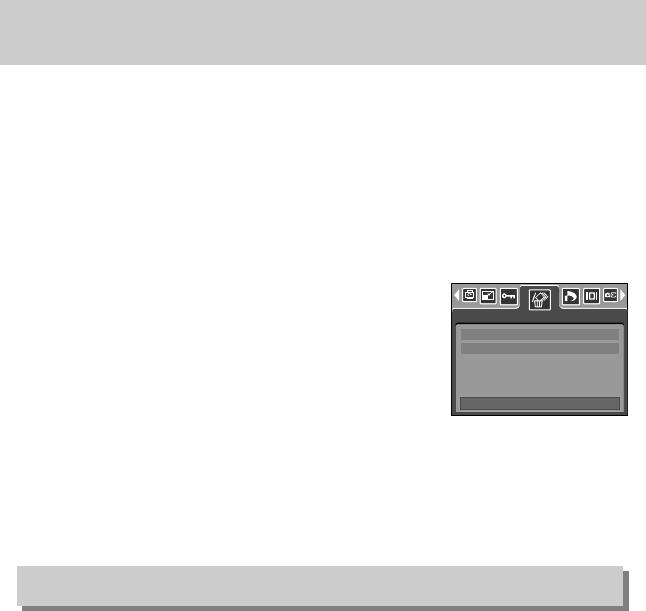
ŝ86Ş
Deleting all images
DPOF
ƈOf all the files stored in the memory card, the unprotected files in the DCIM subfolder will be
deleted. Remember that this will permanently delete unprotected images. Important shots
should be stored on a computer before deletion takes place. The startup image is stored in
the camera's internal memory (i.e., not on the memory card) and it will not be deleted even if
you delete all files on the memory card.
ƃDeleting all images
1. Press the play mode button and press the menu button.
2. Press the LEFT/ RIGHT button and select the
[DELETE ALL] menu tab.
3. Select a desired sub menu by pressing the UP/ DOWN
button and press the OK button.
Selecting [NO] : cancels “Delete All”
Selecting [YES] : Displays the dialogue box to confirm the
delete.
- If [DELETE] is selected : press the OK button and all unprotected pictures are deleted.
- If [CANCEL] is selected : press the OK button and images are not deleted.
ƈDPOF(Digital Print Order Format) allows you to embed printing information on your memory
card’s MISC folder. Select the pictures to be printed and how many prints to make.
ƈThe DPOF indicator will display on the LCD monitor when an image that has DPOF
information plays back. Images can then be printed on DPOF printers, or at an increasing
number of photo labs.
ƈThis function is not available for Movie clips and Voice recording files.
ƈWhen the wide angle image is printed as a real size, 8% of the left and right side of the image
may not be printed. Check that your printer can support the wide angle image when you print
the image. When you print the image on the photo labs, ask them the image has to be printed
as a wide angle image. (Some photo labs may not support the wide angle size print.)
DELETE ALL
NO
YES
EXIT:MENU MOVE:
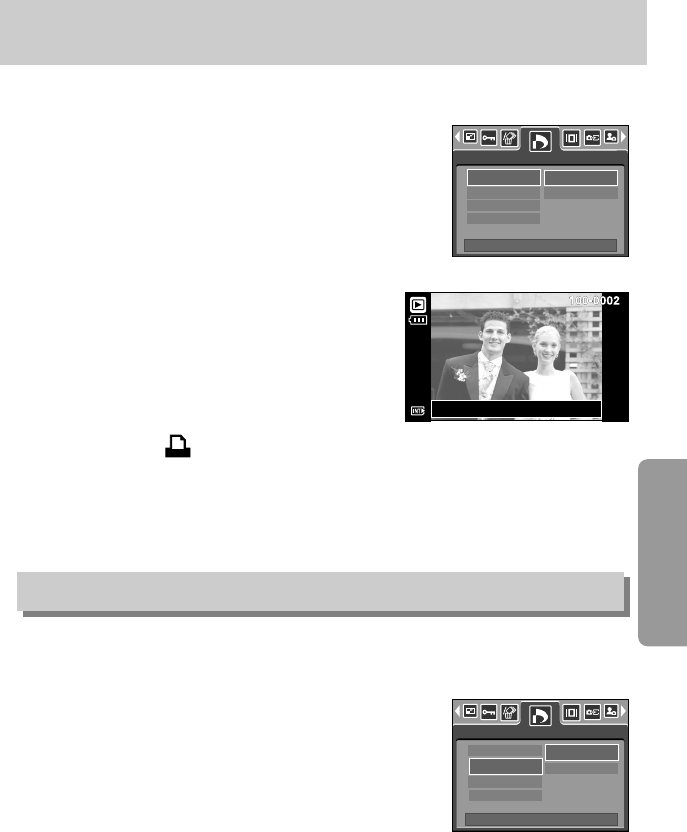
ŝ87Ş
DPOF : STANDARD
DPOF : INDEX
ƈThis function allows you to embed print quantity information on a stored image.
1. Press the play mode button and press the menu button.
2. Press the LEFT/ RIGHT button and select the [DPOF]
menu tab.
3. Select the [STANDARD] menu by pressing the
UP/ DOWN button and press the RIGHT button.
4. Use the UP and DOWN buttons to select [ONE PIC] or
[ALL PICS], and then press the OK button. A window
for selecting number of copies will display.
[ONE PIC] : Set the number of copies to print for the
current picture only.
[ALL PICS] : Set the number of copies to print for each
picture, excluding movie clips and voice
recordings.
5. Use the UP and DOWN buttons to select the number
of copies and then press the OK button.
- The DPOF icon ( ) will appear by the pictures for
which the number of copies to print is set.
ƈImages (except for movie clips and voice file) are printed as index type.
1. Press the play mode button and press the menu button.
2. Press the LEFT/ RIGHT button and select the [DPOF]
menu tab.
3. Select the [INDEX] menu by pressing the UP/ DOWN
button and press the RIGHT button.
4. Select a desired sub menu by pressing the UP/ DOWN
button.
If [NO] is selected : The image will not be printed in
index format.
If [YES] is selected : The image will be printed in index format.
5. Press the OK button to confirm the setting.
6. Press the menu button twice and the menu will disappear.
DPOF
STANDARD
INDEX
PRINT SIZE
CANCEL
ONE PIC
ALL PICS
DPOF
STANDARD
INDEX
PRINT SIZE
CANCEL
NO
YES
BACK:SET:OK
SET:OK EXIT:SH1
PREVȜȞ
NEXT
0 PRINTS
BACK:SET:OK
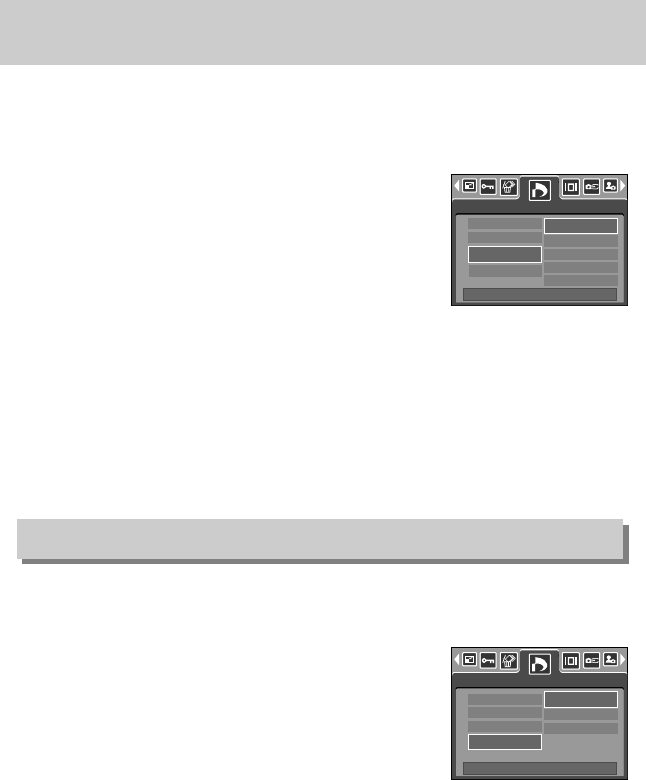
ŝ88Ş
DPOF : PRINT SIZE
ƈYou can specify the print size when printing images stored on the memory card.
The [PRINT SIZE] menu is available only for DPOF 1.1 compatible printers.
ƃSetting the Print Size
1. Press the play mode button and press the menu button.
2. Press the LEFT/ RIGHT button and select the [DPOF]
menu tab.
3. Select the [PRINT SIZE] menu by pressing the
UP/ DOWN button and press the RIGHT button.
4. Select a desired sub menu by pressing the UP/ DOWN
button and press the OK button.
DPOF : CANCEL
ƈYou can cancel the [STANDARD], [INDEX], or [PRINT SIZE] settings. Cancel the setting to
reset the value to its default.
1. Press the play mode button and press the menu button.
2. Press the LEFT/ RIGHT button and select the [DPOF]
menu tab.
3. Select the [CANCEL] menu by pressing the UP/ DOWN
button and press the RIGHT button.
4. Select a desired sub menu by pressing the UP/ DOWN
button.
If [STANDARD] is selected : Cancels the standard print setting.
If [INDEX] is selected : Cancels the index print setting.
If [PRINT SIZE] is selected : Cancels the print size setting.
5. Press the OK button to confirm the setting.
* PRINT SIZE : DEFAULT, 3X5, 4X6, 5X7, 8X10
* The [DEFAULT] print size varies depending on the printer manufacturer.
For your printer's default value, please refer to the user's guide that came with your printer.
DPOF
STANDARD
INDEX
PRINT SIZE
CANCEL
DEFAULT
3X5
4X6
5X7
8X10
BACK:SET:OK
DPOF
STANDARD
INDEX
PRINT SIZE
CANCEL
STANDARD
INDEX
PRINT SIZE
BACK:SET:OK
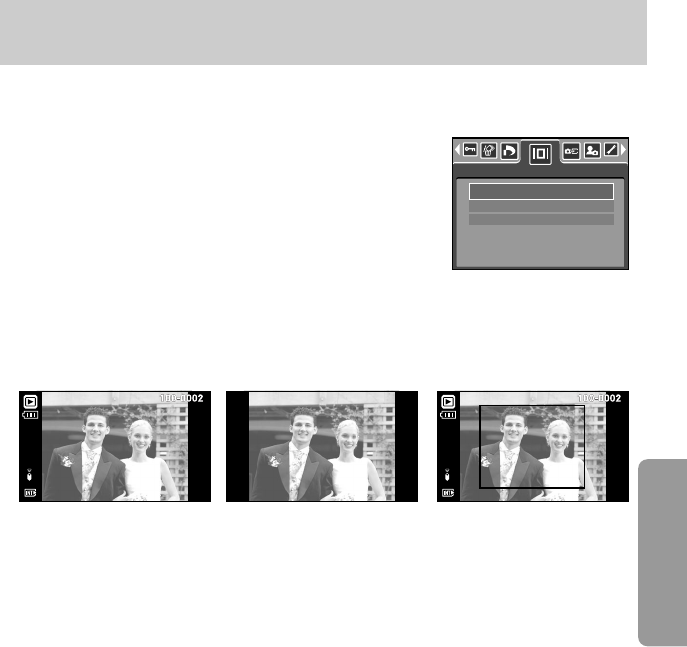
ŝ89Ş
On Screen Display information
ƈYou can check shooting information about the displayed image.
1. Press the play mode button and press the menu button.
2. Select the [OSD INFORMATION] menu tab by pressing
the LEFT/ RIGHT button.
3. Select a desired sub menu by pressing the UP/ DOWN
button.
- [FULL OSD] : All information shown as below is displayed.
- [BASIC OSD] : Some information shown as below is
displayed.
- [IMAGE INFORMATION] : Shooting information about the
displayed image is displayed.
4. Press the OK button to confirm the setting.
OSD INFORMATION
FULL OSD
BASIC OSD
IMAGE INFORMATION
[FULL OSD] [BASIC OSD] [IMAGE INFORMATION]
SIZE : 2592X1944
AV : F3.3
TV : 10/60
ISO : 100
FLASH : OFF
DATE : 2005/08/01
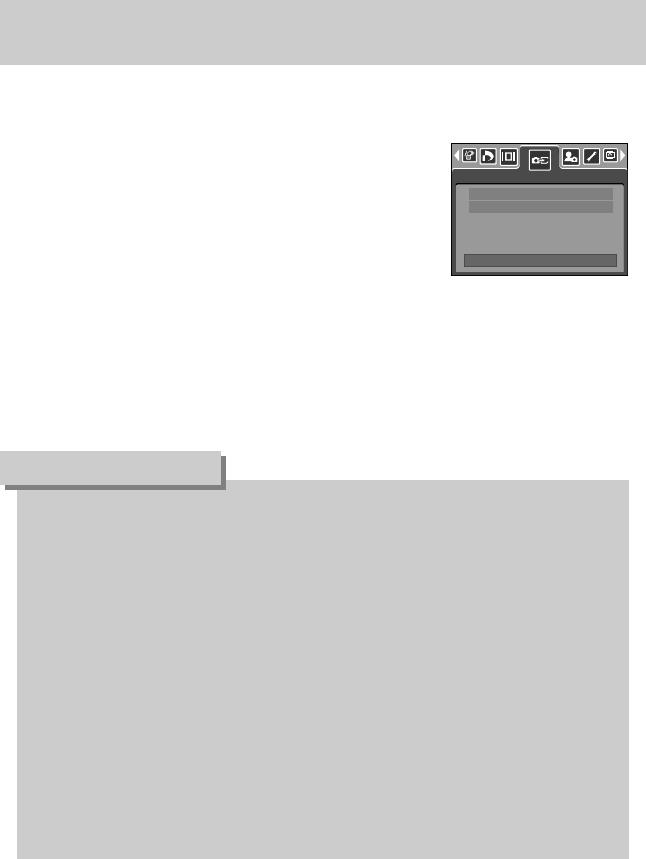
ŝ90Ş
Copy To Card
ƈThis enables you to copy image files, movie clips and voice recording files to the memory card.
ƃCopying to the Memory Card
1. Press the play mode button and press the menu button.
2. Select the [COPY TO CARD] menu tab by pressing the
LEFT/ RIGHT button.
3. Select a desired sub menu by pressing the UP/ DOWN
button and press the OK button.
- [NO] : Cancels "Copy to Card".
- [YES]: All images, movie clips and voice recording files
saved in the internal memory are copied to the memory card after the
[Processing!] message is displayed. After copying has been completed, the
screen will return to play mode.
ƃWhen this menu is selected without inserting a memory card, you can select the
[COPY TO CARD] menu but the menu can’t be run.
ƃIf there is not enough space available in the memory card to copy saved images in the
internal memory (24MB), the [COPY TO CARD] command will copy only some of the
images and display [CARD FULL!] message. Then the system will return to the playback
mode. Please be sure to delete any unnecessary files to free up space before inserting
the memory card into the camera.
ƃWhen you move the images that are stored in the internal memory by doing [COPY TO
CARD] to the card, the next number of file names will be created in the card to avoid
duplication of the file name.
- When the [RESET] of the [FILE] setup menu was set : The copied file names start from
after the last stored file name.
- When the [SERIES] of the [FILE] setup menu was set : The copied file names start from
after the last captured file name. After completing [COPY TO CARD], the last stored
image of the last copied folder is displayed on the LCD monitor.
INFORMATION
COPY TO CARD
NO
YES
EXIT:MENU MOVE:
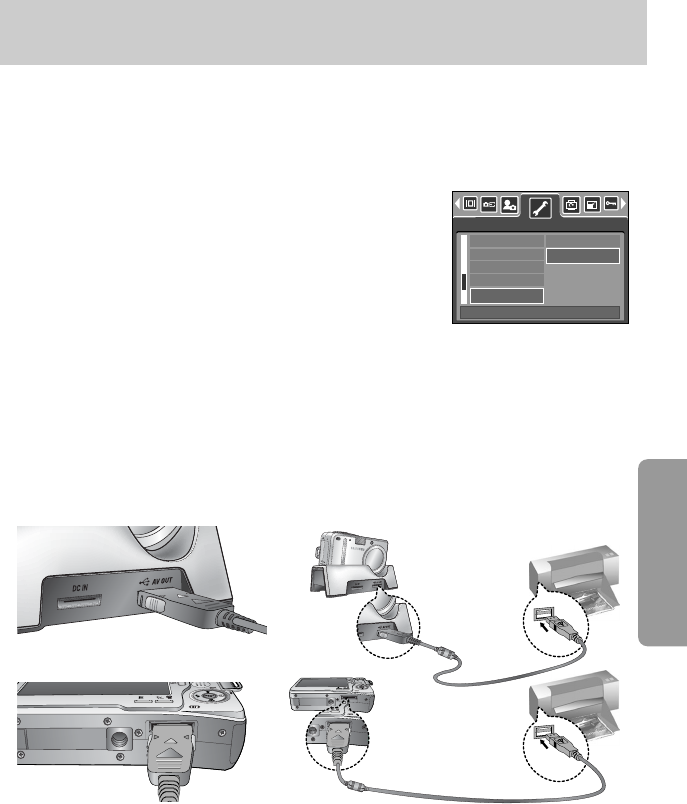
ŝ91Ş
PictBridge
[Using the USB cable with Cradle]
[Using the USB cable with Camera]
ƈConnecting the Camera to a Printer
ƃUsing the USB cable with Cradle :
Connect the camera and the cradle. Connect the cradle to a printer’s USB port with the
supplied USB cable.
ƃUsing the USB cable with Camera :
Connect the camera to a printer’s USB port with the supplied USB cable.
ſIf you selected [COMPUTER] in Step 4, when you connect the camera to your printer, the
[CONNECTING COMPUTER] message will display and the connection will not be
established. In this case, disconnect the USB cable, and then follow the procedure from Step
2 and onward. Or, press the Printer button and the camera is connected to the printer
displaying the [CONNECTING PRINTER] message. But, the camera may not connect to the
printer and turn off according to the printer manufacturer.
ƈYou can use the USB cable to connect this camera to a printer that supports PictBridge (sold
separately) and print the stored images directly. Movie clips and voice files cannot be printed.
ƃSetting up the camera for connection with the printer
1. In any mode with the exception of Voice Recording mode,
press the MENU button.
2. Press the LEFT/ RIGHT button and select [SETUP] menu
tab.
3. Select [USB] menu by pressing the UP/ DOWN button and
press the RIGHT button.
4. Select [PRINTER] menu by pressing the UP/ DOWN button
and press the OK button.
DATE&TIME
IMPRINT
AF LAMP
SOUND
USB
COMPUTER
PRINTER
SETUP
BACK:SET:OK
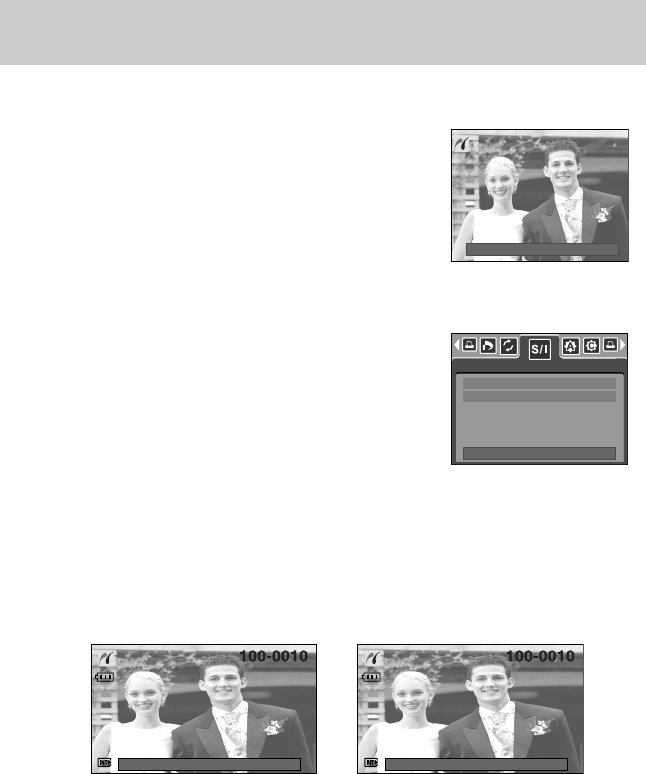
ŝ92Ş
PictBridge : Picture Selection
ƈEasy printing
When you connect the camera to printer in the Play back
mode, you can print a picture easily.
- Pressing the shutter button : Currently displayed image will
be printed with the printer’s
default setting.
- Pressing the Left/ Right button : Selects a previous/ next
image.
- Press the Up/ Down button to select the number of prints.
- When [ONE PIC] is selected : Use the Left/ Right button to select another picture and select
the number of prints for another picture.
- After setting the number of prints, press the OK button to save.
- Press the Shutter button to return to the menu without setting the number of prints.
ƃSetting the Number of Copies to Print
-Select [ONE PIC] or [All PICS]. A screen where you can set the number of copies to print
will appear as shown below.
ƈSelect pictures to print
1. Press the Menu button.
2. The [IMAGES] menu will appear.
3. Use the UP and DOWN buttons to select the desired
submenu value, and then press the OK button.
When [ONE PIC] is selected : The PictBridge function will
be applied only to the
picture currently displayed.
When [All PICS] is selected : The PictBridge function will be applied to all pictures,
excluding movie clips and voice files.
IMAGES
MOVE:
ONE PIC
ALL PICS
[When [ONE PIC] is selected]
0 PRINTS
PREV ȜȞ
NEXT
Ɗ
ƌ
SET:OK EXIT:SH1
[When [All PICS] is selected]
0 PRINTS
Ɗ
ƌ
SET:OK EXIT:SH1
PRINT:SHUTTER MENU:OK
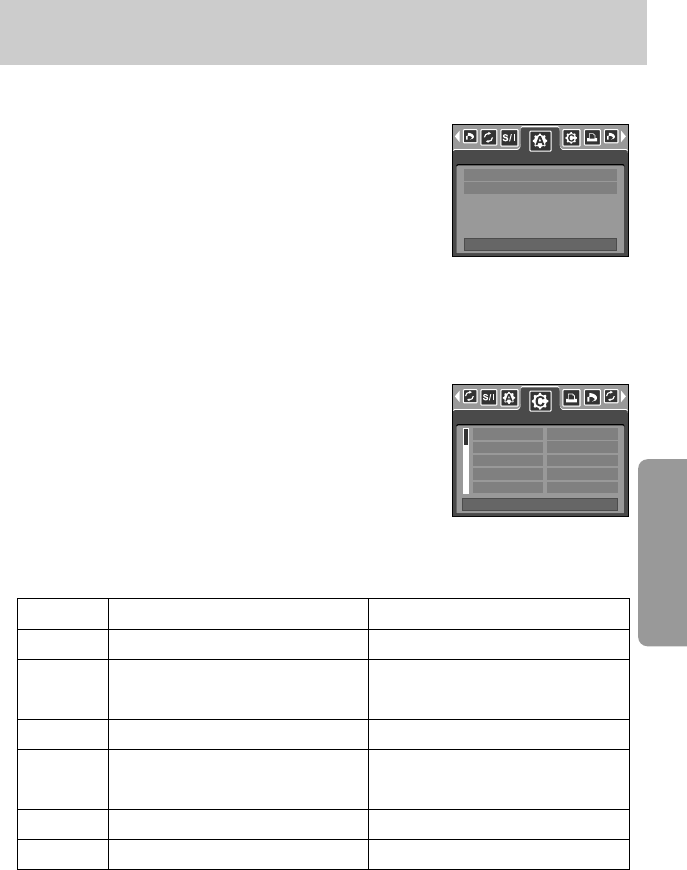
ŝ93Ş
PictBridge : Print Setting
Menu
SIZE Setting the size of the printing paper
AUTO, POSTCARD, CARD, 4 X 6, L, 2L, LETTER, A4, A3
Setting the number of pictures to be
printed on a sheet of paper
TYPE Setting the quality of the printing paper
AUTO, PLAIN, PHOTO, FASTPHO.
Setting the quality of the picture to be
printed
DATE Setting whether to print the date AUTO, OFF, ON
FILE NAME Setting whether to print the file name AUTO, OFF, ON
ƈAUTO SET
1. Use the LEFT and RIGHT buttons to select the
[AUTO SET] menu tab.
2. Use the UP and DOWN buttons to select the desired
submenu value, and then press the OK button.
[NO] : [CUSTOM SET] values are kept.
[YES] : All values in the [CUSTOM SET] are
automatically changed.
ſSome menu options are not supported in all manufacturer and printer models.
If not supported, the menus are still displayed in the LCD, but are not selectable.
ſIf the setting values are not changed in the automatic/ manual setting, the setting values are
automatically kept.
ƃThe menus you can set up are as follows:
LAYOUT AUTO, FULL, 1, 2, 4, 8, 9, 16
AUTO, DRAFT, NORMAL, FINE
QUALITY
1. Use the LEFT and RIGHT buttons to select the
[CUSTOM SET] menu tab.
2. Use the UP and DOWN buttons to select the desired
submenu value, and then press the RIGHT button.
3. Use the UP and DOWN buttons to select the desired
submenu value, and then press the OK button.
ƈCustom Set : You can select the Paper Size, Print Format, Paper Type, Print Quality, Date
Print, and File Name Print menus for printed pictures.
Function Sub menu
AUTO SET
NO
YES
SIZE
LAYOUT
TYPE
QUALITY
DATE
AUTO
AUTO
AUTO
AUTO
AUTO
CUSTOM SET
MOVE:
MOVE:
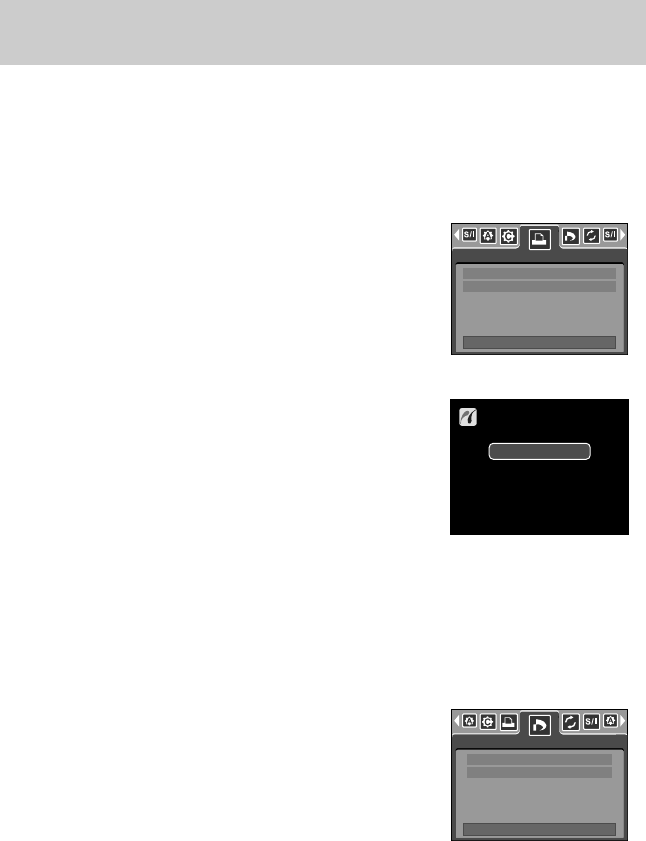
ŝ94Ş
PictBridge : Printing
ƈWhen the wide angle image is printed as a real size, 8% of the left and right side of the image
may not be printed. Check that your printer can support the wide angle image when you print
the image. When you print the image on the photo labs, ask them the image has to be printed
as a wide angle image. (Some photo labs may not support the wide angle size print.)
ƈPrinting Pictures
1. Use the LEFT and RIGHT buttons to select the [PRINT]
menu tab.
2. Use the UP and DOWN buttons to select the desired
submenu value, and then press the OK button.
[STANDARD] : Print the pictures stored in the memory card
in set numbers. One picture is printed on
one piece of paper.
[INDEX] : Print multiple images on one sheet of paper.
3. The screen shown on the right will appear and the picture
will be printed. If no picture is selected, the [NO IMAGE!]
message will be displayed. Press the shutter button while
printing to cancel the printing and the [IMAGES] menu is
displayed.
ſNumber of pictures in an index print varies depends on the
printer used.
1. Use the LEFT and RIGHT buttons to select the
[DPOF PRINT] menu tab.
2. Use the UP and DOWN buttons to select the desired
submenu value, and then press the OK button.
[NO] : Cancel the printing
[YES] : Directly print the file with the DPOF information
ſDepending on the manufacturer and printer model, some
menus may not be available.
With a printer without supporting the DPOF, the menu is still displayed but not available.
ƈDPOF Print : This allows you to directly print the files with DPOF information.
001/026
EXIT:SH1
NOW PRINTING
PRINT
STANDARD
INDEX
DPOF PRINT
NO
YES
MOVE:
MOVE:
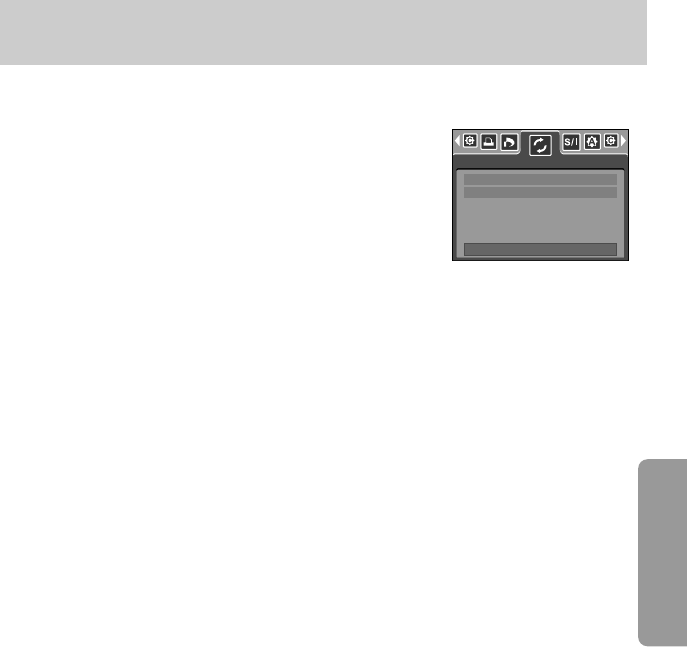
ŝ95Ş
PictBridge : RESET
1. Use the LEFT and RIGHT buttons to select the [RESET]
menu tab.
2. Use the UP and DOWN buttons to select the desired
submenu value, and then press the OK button.
If [NO] is selected : Settings will not be reset.
If [YES] is selected : All print and image settings will be
reset.
ſDefault print setting varies depending on the printer manufacturer.
For your printer’s default setting, refer to the user’s guide that came with your printer.
ƈInitialises user-changed configurations.
RESET
NO
YES
MOVE:
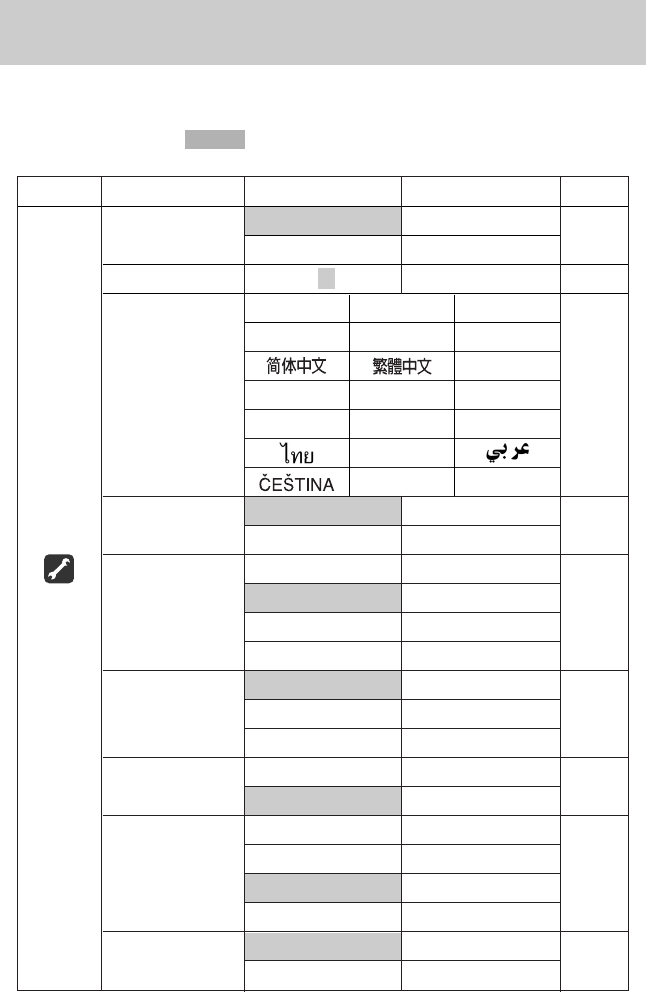
ŝ96Ş
Setup menu
Menu tab Main menu Sub menu Secondary menu Page
SERIES -
RESET -
PWR SAVE OFF, 1, 3, 5MIN - p.98
ENGLISH ጥૹ FRANÇAIS
DEUTSCH ESPAÑOL ITALIANO
⁹ᷘ
LANGUAGE
P”CCK»…
PORTUGUÊS
DUTCH p.99
DANSK SVENSKA SUOMI
BAHASA
POLSKI MAGYAR
NO -
YES -
05/01/01 13:00 OFF
YYYY/MM/DD -
DD/MM/YYYY -
MM/DD/YYYY -
OFF -
IMPRINT DATE - p.100
DATE&TIME -
OFF -
ON -
OFF -
LOW -
MEDIUM -
HIGH -
COMPUTER
PRINTER
FILE
DATE&TIME
SOUND
USB
p.97
p.99
p.101
p.102
p.100
p.101
ƈIn this mode, you can set up basic settings. You can use the setup menu in all camera
modes, except Voice Recording mode.
The items indicated by are default settings.
FORMAT
AF LAMP
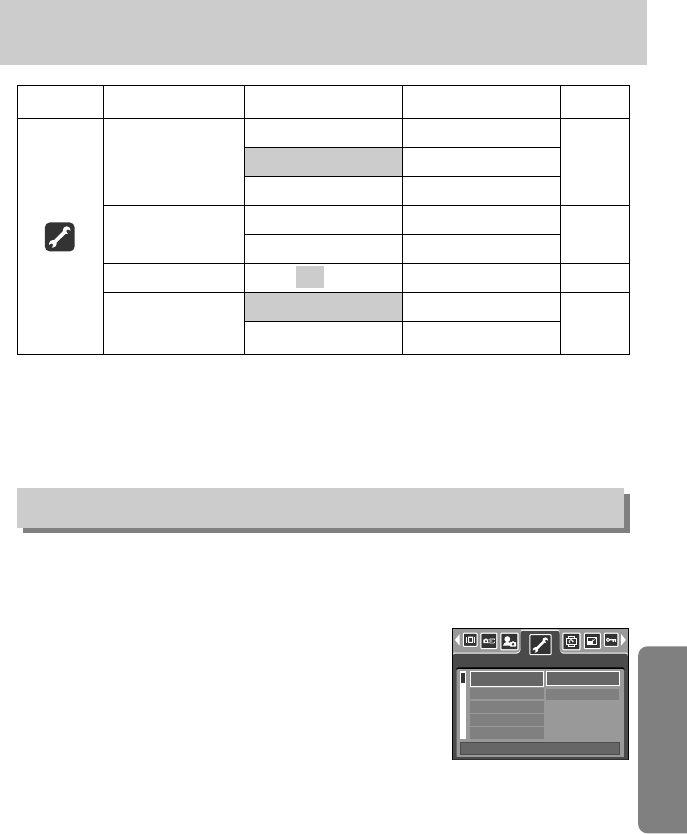
ſMenus are subject to change without prior notice.
ƈThis function allows the user to select the file naming format.
ƃAssigning File Names
1. In any mode with the exception of Voice Recording mode,
press the MENU button.
2. Press the LEFT/ RIGHT button and select the [SETUP]
menu tab.
3. Select the [FILE] menu by pressing the UP/ DOWN button
and press the RIGHT button.
4. Select a desired sub menu by pressing the UP/ DOWN
button and press the OK button.
[SERIES] : New files are named using numbers that follow the previous sequence, even
when a new memory card is used, or after formatting, or after deleting all
pictures.
[RESET] : After using the reset function, the next file name will be set from 0001 even
after formatting, deleting all or inserting a new memory card.
5. Press the menu button twice and the menu will disappear.
File name
FILE
PWR SAVE
LANGUAGE
FORMAT
DATE&TIME
SERIES
RESET
SETUP
BACK :SET:OK
Menu tab Main menu Sub menu Secondary menu Page
DARK -
LCD NORMAL - p.102
BRIGHT -
NTSC -
PAL -
Q.VIEW OFF, 0.5, 1, 3SEC - p.105
NO -
YES -
Setup menu
ŝ97Ş
p.103
p.105
RESET
VIDEO
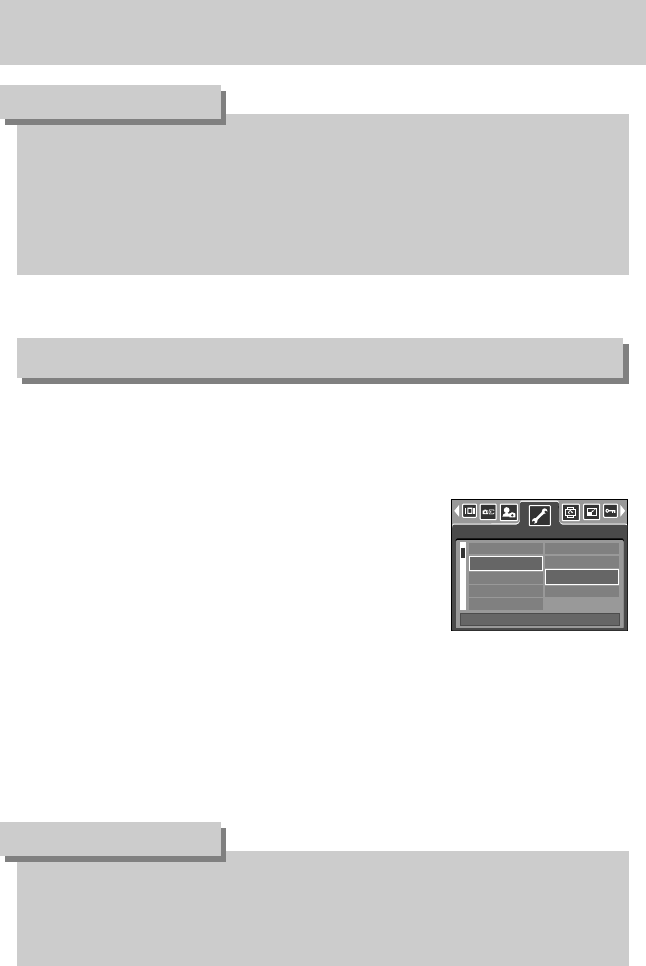
ŝ98Ş
File name
ƃThe first stored folder name is 100SSCAM, and the first file name is SL550001.
ƃFile names are assigned sequentially from SL550001 ƍSL550002 ƍ~ ƍSL559999.
ƃThe folder number is assigned sequentially from 100 to 999 as follows:
100SSCAM ƍ101SSCAM ƍ~ ƍ999SSCAM.
ƃThe files used with the memory card conform to the DCF(Design rule for Camera File
systems) format.
INFORMATION
ƃEven if the battery is removed and inserted again, the power off setting will be preserved.
ƃNote that the automatic power off function will not operate if the camera is in PC mode,
slide show, playing back a voice recording and playing back a movie clip.
INFORMATION
Auto power off
ƃSetting Power Off
1. In any mode with the exception of Voice Recording mode,
press the MENU button.
2. Press the LEFT/ RIGHT button and select the [SETUP]
menu tab.
3. Select the [PWR SAVE] menu by pressing the
UP/ DOWN button and press the RIGHT button.
4. Select a desired sub menu by pressing the UP/ DOWN
button and press the OK button.
[OFF]: The power off function will not operate.
[1, 3, 5 MIN] : The power will turn off automatically if not used for the period of time
specified.
5. Press the menu button twice and the menu will disappear.
ƈThis function switches the camera off after a set amount of time in order to prevent
unnecessary battery drainage.
FILE
PWR SAVE
LANGUAGE
FORMAT
DATE&TIME
OFF
1MIN
3MIN
5MIN
SETUP
ಒൂ:ȜჄ:OK
BACK:SET:OK
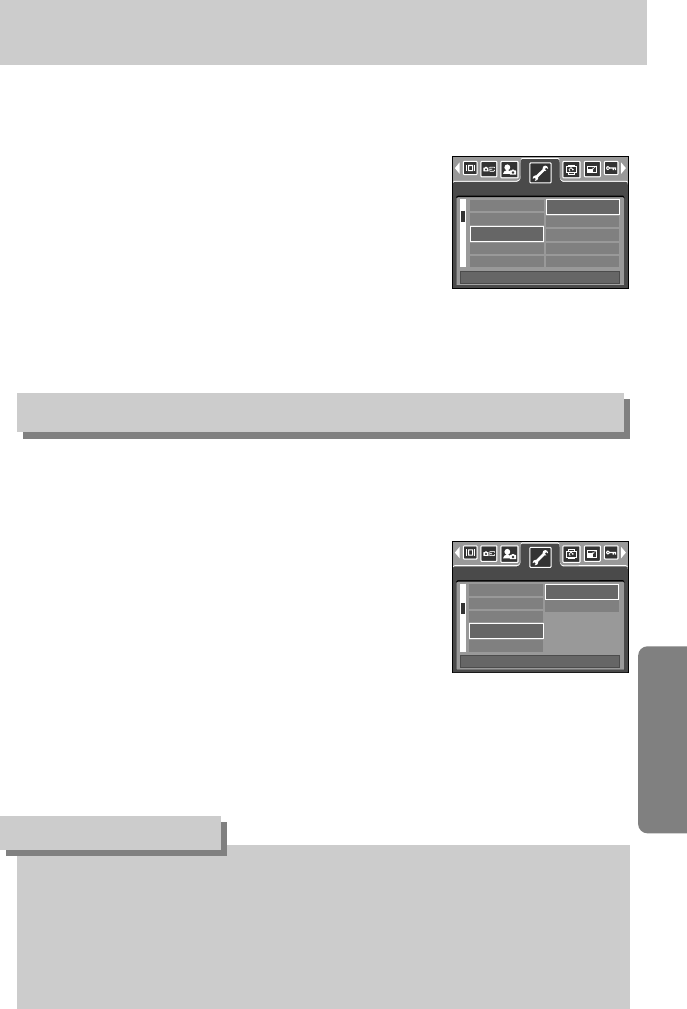
ŝ99Ş
Language
ƃSetting Language
1. In any mode with the exception of Voice Recording mode,
press the MENU button.
2. Press the LEFT/ RIGHT button and select the [SETUP] menu tab.
3. Select the [LANGUAGE] menu by pressing the
UP/ DOWN button and press the RIGHT button.
4. Select a desired sub menu by pressing the UP/ DOWN
button and press the OK button.
LANGUAGE sub menu : English, Korean, French, German,
Spanish, Italian, S.Chinese, T.Chinese, Japanese, Russian, Portuguese, Dutch, Danish, Swedish,
Finnish, Thai, BAHASA(MALAY/ INDONESIAN), Arabic, Hungarian, Czech and Polish.
5. Press the menu button twice and the menu will disappear.
ƃFormatting a memory
1. In any mode other than Voice Recording mode, press the
MENU button.
2. Press the LEFT/ RIGHT button and select the [SETUP] menu tab.
3. Select the [FORMAT] menu by pressing the UP/ DOWN
button and press the RIGHT button.
4. Select a desired sub menu by pressing the UP/ DOWN
button and press the OK button.
If [NO] is selected : The memory will not be formatted.
Press the menu button twice and the menu display will disappear.
If [YES] is selected : A confirmation window will display. Select the [FORMAT]
message. A [PROCESSING!] message appears and the memory
will be formatted. If you ran FORMAT in Play mode, a [NO
IMAGE!] message will appear.
ƈThere is a choice of languages that can be displayed on the LCD monitor. Even if the battery
is removed and inserted again, the language setting will be preserved.
Formatting a memory
ƈThis is used for formatting the memory. If you run [FORMAT] on the memory, all images,
including the protected images, will be deleted. Be sure to download important images to your
PC before formatting the memory.
ƃBe sure to run [FORMAT] on the following types of memory card.
- A new memory card, or an unformatted memory card.
- A memory card that has a file this camera can't recognise or one that has been taken
from another camera.
ƃAlways format the memory card using this camera. If you insert a memory card that has
been formatted using other cameras, memory card readers, or PCs, you will get a [CARD
ERROR!] message.
INFORMATION
FILE
PWR SAVE
LANGUAGE
FORMAT
DATE&TIME
ENGLISH
ጥૹ
FRANÇAIS
DEUTSCH
ESPAÑOL
SETUP
FILE
PWR SAVE
LANGUAGE
FORMAT
DATE&TIME
NO
YES
SETUP
BACK:SET:OK
BACK:SET:OK
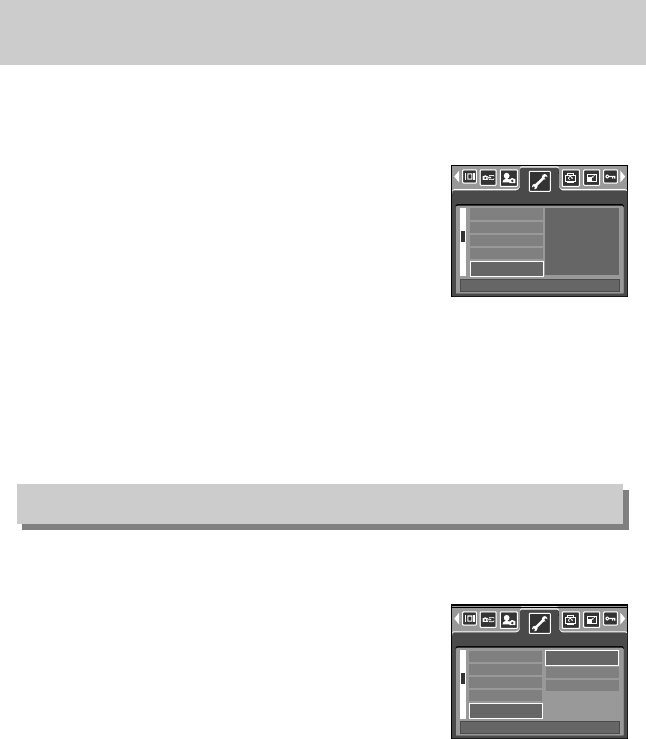
ŝ100Ş
Setting up the Date / Time / Date type
ƈYou can change the date and time that will be displayed on the captured images and set up the
date type.
ƃSetting Date / Time & Selecting Date Format
1. In any mode with the exception of Voice Recording mode,
press the MENU button.
2. Press the LEFT/ RIGHT button and select the [SETUP]
menu tab.
3. Select the [DATE&TIME] menu by pressing the
UP/ DOWN button and press the RIGHT button.
4. Use the UP, DOWN, LEFT, and RIGHT buttons to select
the desired submenu value, and then press the OK button.
RIGHT button : Selects the year/ month/ day/ hour/ minute date type.
LEFT button : Moves the cursor to the [DATE&TIME] main menu if the cursor is at the
first item of the date and time setup. In all other cases, the cursor will be
shifted to the left of its current position.
UP and DOWN buttons : Changes the setting value.
5. Press the menu button twice and the menu will disappear.
ƈThere is an option to include DATE/ TIME on still images.
ƃDate Imprinting
1. In any mode with the exception of Voice Recording mode,
press the MENU button.
2. Press the LEFT/ RIGHT button and select the [SETUP]
menu tab.
3. Select the [IMPRINT] menu by pressing the UP/ DOWN
button and press the RIGHT button.
4. Use the UP and DOWN buttons to select the desired date
imprint type, and then press the OK button.
[OFF] : The DATE & TIME will not be imprinted on the image file.
[DATE] : Only the DATE will be imprinted on the image file.
[DATE&TIME] : The DATE & TIME will be imprinted on the image file.
5. Press the menu button twice and the menu will disappear.
ſThe Date & Time are imprinted at the bottom right side of the still image.
ſThe date will be imprinted as a [DATE&TIME] setting.
ſTIME is imprinted in the following way : [Hour : Minute] and hours are shown using the
24 hour clock.
ſIf you select the continuous shooting, the date doesn’t be imprinted.
Imprinting the recording date
ಒൂ:ȜჄ:OK
FILE
PWR SAVE
LANGUAGE
FORMAT
DATE&TIME
05/08/01 13:00
YYYY/MM/ DD
SETUP
Ɗ
ƌ
PWR SAVE
LANGUAGE
FORMAT
DATE&TIME
IMPRINT
OFF
DATE
DATE&TIME
SETUP
BACK:SET:OK
BACK:SET:OK
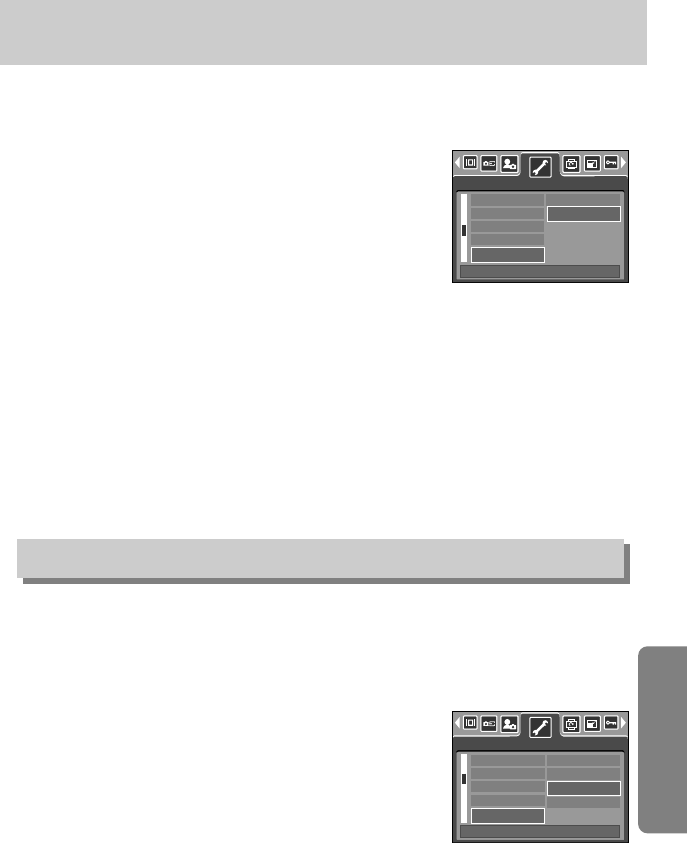
ŝ101Ş
Auto Focus lamp
ƈIf you set the operation sound to ON, various sounds will be activated for camera startup,
when button are pressed, and if there is a card error, so that you can be aware of the camera
operation status.
ƃSetting Operation Sounds
1. In any mode with the exception of Voice Recording mode,
press the MENU button.
2. Press the LEFT/ RIGHT button and select the [SETUP]
menu tab.
3. Select the [SOUND] menu by pressing the UP/ DOWN
button and press the RIGHT button.
4. Select a desired sub menu by pressing the UP/ DOWN
button and press the OK button.
[SOUND] sub menu : OFF/ LOW/ MEDIUM/ HIGH
5. Press the menu button twice and the menu will disappear.
Sound
ƃHow to set up the lamp
1. In any mode with the exception of Voice Recording mode,
press the MENU button.
2. Press the LEFT/ RIGHT button and select the [SETUP]
menu tab.
3. Select the [AF LAMP] menu by pressing the UP/ DOWN
button and press the RIGHT button.
4. Select a desired sub menu by pressing the UP/ DOWN
button and press the OK button.
If [OFF] is selected : The AF lamp will not light up.
If [ON] is selected : The AF lamp will light up.
ſIf you select [OFF] menu and take an image in poorly lit conditions or select the [NIGHT]
scene mode, the camera may not take exact focus.
ƈYou can turn on and off the Auto Focus lamp
LANGUAGE
FORMAT
DATE&TIME
IMPRINT
AF LAMP
SETUP
OFF
ON
FORMAT
DATE&TIME
IMPRINT
AF LAMP
SOUND
OFF
LOW
MEDIUM
HIGH
SETUP
BACK:SET:OK
BACK:SET:OK
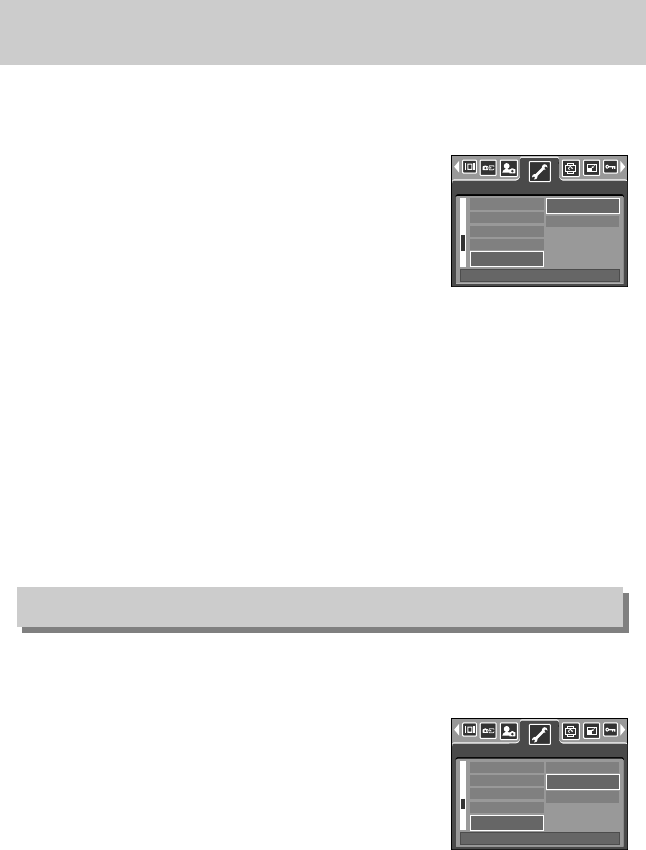
Connecting an External Device (USB)
ŝ102Ş
ƈYou can select an external device to which you want to connect the camera using the USB
cable.
ƃSelecting an External Device
1. In any mode with the exception of Voice Recording mode,
press the MENU button.
2. Press the LEFT/ RIGHT button and select the [SETUP]
menu tab.
3. Select the [USB] menu by pressing the UP/ DOWN button
and press the RIGHT button.
4. Select a desired sub menu by pressing the UP/ DOWN
button and press the OK button.
[COMPUTER] : Select this if you want to connect the camera to your PC.
Refer to page 127 for instructions on how to connect the camera to your
PC.
[PRINTER] : Select this if you want to connect the camera to your printer.
Refer to page 91 for instructions on how to connect the camera to your
printer.
5. Press the menu button twice and the menu will disappear.
DATE&TIME
IMPRINT
AF LAMP
SOUND
USB
COMPUTER
PRINTER
SETUP
ƈYou can adjust the LCD brightness.
ƃAdjusting LCD Brightness
1. In any mode with the exception of Voice Recording mode,
press the MENU button.
2. Press the LEFT/ RIGHT button and select the [SETUP]
menu tab.
3. Select the [LCD] menu by pressing the UP/ DOWN button
and press the RIGHT button.
4. Select a desired sub menu by pressing the UP/ DOWN
button and press the OK button.
[LCD] sub menu : DARK, NORMAL, BRIGHT
5. Press the menu button twice and the menu will disappear.
IMPRINT
AF LAMP
SOUND
USB
LCD
DARK
NORMAL
BRIGHT
SETUP
LCD brightness
BACK:SET:OK
BACK:SET:OK
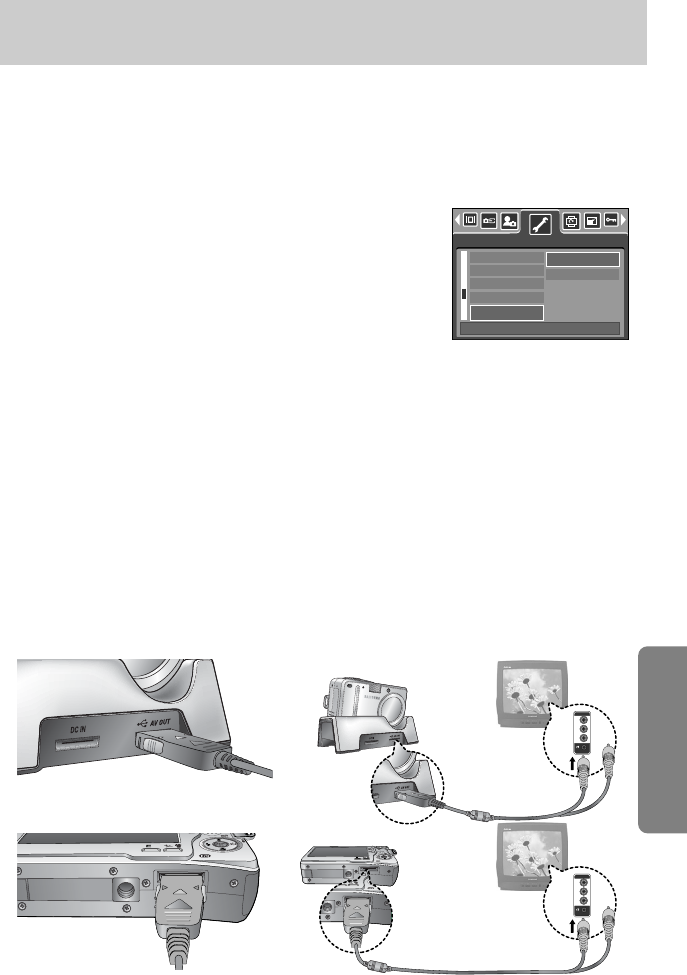
ŝ103Ş
Selecting Video out type
ƈThe Movie output signal from the camera can be NTSC or PAL.
Your choice of output will be governed by the type of device (monitor or TV, etc.) to which the
camera is connected. PAL mode can support only BDGHI.
ƃSetting the Video Out Type
1. In any mode with the exception of Voice Recording mode,
press the MENU button.
2. Press the LEFT/ RIGHT button and select the [SETUP]
menu tab.
3. Select the [VIDEO] menu by pressing the UP/ DOWN
button and press the RIGHT button.
4. Select a desired sub menu by pressing the UP/ DOWN
button and press the OK button.
- [VIDEO] sub menu : NTSC, PAL
5. Press the menu button twice and the menu will disappear.
AF LAMP
SOUND
USB
LCD
VIDEO
NTSC
PAL
SETUP
ƈConnecting to an external monitor
ƃUsing the AV cable with Cradle : Connect the camera and the cradle.
Connect the cradle to an external monitor with the
supplied AV cable.
ƃUsing the AV cable with Camera : Connect the camera to an external monitor with the
supplied AV cable.
[Using the AV cable with Cradle]
[Using the AV cable with Camera]
BACK:SET:OK
Yellow - Video
White - sound
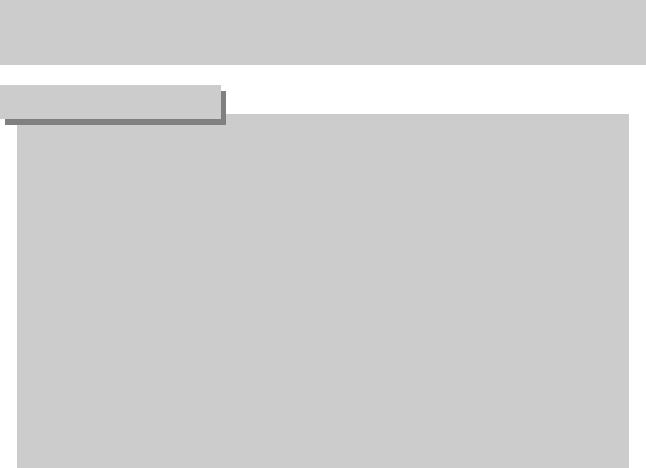
ŝ104Ş
Selecting Video out type
ƃNTSC : U.S.A, Canada, Japan, South Korea, Taiwan, Mexico.
ƃPAL : Australia, Austria, Belgium, China, Denmark, Finland, Germany, U.K., Holland,
Italy, Kuwait, Malaysia, New Zealand, Singapore, Spain, Sweden, Switzerland,
Thailand, Norway.
ƃWhen using a TV as an external monitor, you will need to select the external or AV
channel of the TV.
ƃThere will be a digital noise on the external monitor, but it is not a malfunction.
ƃIf the image is not in the centre of the screen, use the TV controls to centre it.
ƃWhen the camera is connected to an external monitor, the menu will be visible on the
external monitor and the menu functions are the same as those indicated on the LCD
monitor.
ƃSelecting the PAL video out type, the TV monitor turns off and the LCD monitor of the
camera turns on when you take a movie clip. After completing the recording, the TV
monitor turns on and the LCD monitor of the camera turns off.
INFORMATION
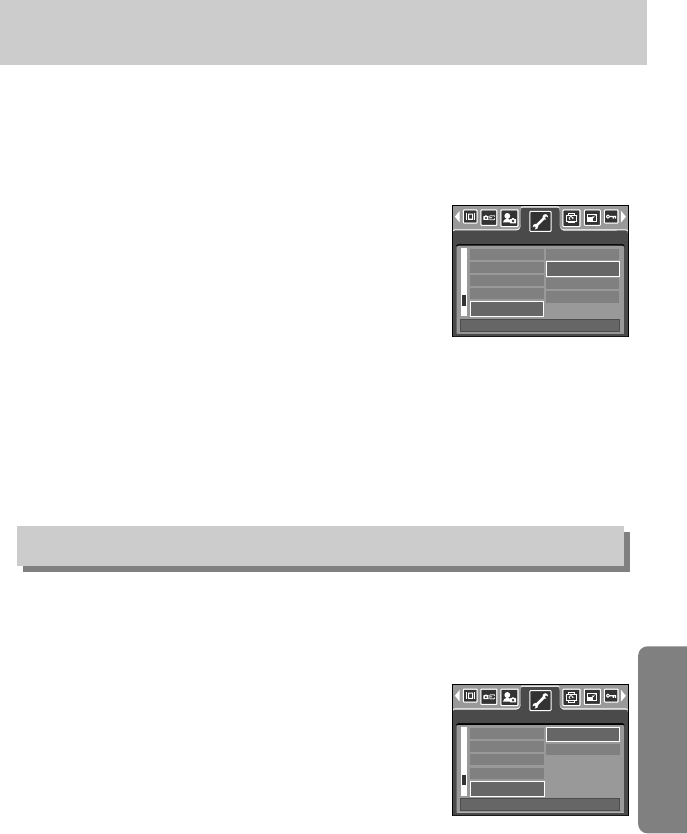
ŝ105Ş
Quick view
ƈIf you enable Quick View before capturing an image, you can view the image you just
captured on the LCD monitor for the duration set in the [Q.VIEW] setup. Quick view is
possible only with still images.
ƃSetting Quick View
1. In any mode with the exception of Voice Recording mode,
press the MENU button.
2. Press the LEFT/ RIGHT button and select the [SETUP]
menu tab.
3. Select the [Q.VIEW] menu by pressing the UP/ DOWN
button and press the RIGHT button.
4. Select a desired sub menu by pressing the UP/ DOWN
button and press the OK button.
[OFF] : The quick view function can’t be activated.
[0.5, 1, 3SEC] : The captured image is briefly displayed during the selected time.
5. Press the menu button twice and the menu will disappear.
Initialisation
ƈAll camera menu and function settings will be restored to their default values.
However, values for DATE/TIME, LANGUAGE, and VIDEO OUT will not be changed.
ƃInitialising the Camera
1. In any mode with the exception of Voice Recording mode,
press the MENU button.
2. Press the LEFT/ RIGHT button and select the [SETUP]
menu tab.
3. Select the [RESET] menu by pressing the UP/ DOWN
button and press the RIGHT button.
4. Select a desired sub menu by pressing the UP/ DOWN
button and press the OK button.
If [NO] is selected : Settings will not be restored to their defaults.
If [YES] is selected : A confirmation window will display. Select the [YES] menu and press
the OK button. All settings will be restored to their defaults.
SOUND
USB
LCD
VIDEO
Q.VIEW
OFF
0.5 SEC
1 SEC
3 SEC
SETUP
USB
LCD
VIDEO
Q.VIEW
RESET
NO
YES
SETUP
BACK:SET:OK
BACK:SET:OK
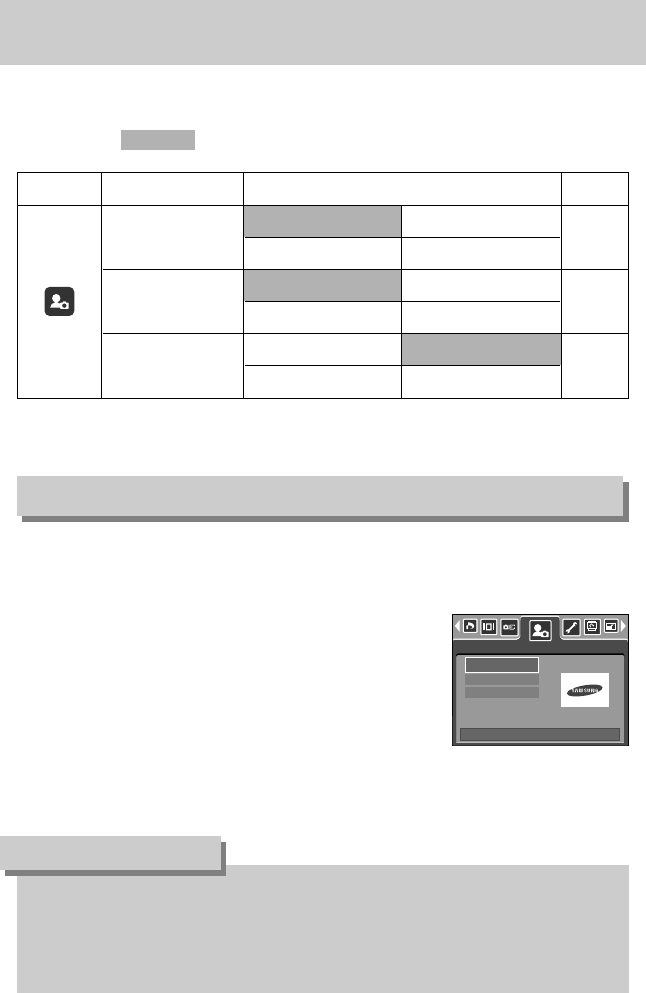
ŝ106Ş
Setting up the Mycam menu
ƈYou can set up a start up image, start up sound and shutter sound. Every camera working
mode (with the exception of Voice recording mode) has the MyCAM menu. The items
indicated by are default settings.
Menu tab Main menu Sub menu Page
OFF LOGO
USER IMAGE 1 USER IMAGE 2
OFF SOUND 1
SOUND 2 SOUND 3
OFF SH.SOUND 1
SH.SOUND 2 SH.SOUND 3
S.IMAGE
S.SOUND
SH.SOUND
p.106
p.107
p.107
ƈYou can select the image that is first displayed on the LCD monitor whenever the camera is
turned on.
ƃSetting a Startup Image
1. In any mode with the exception of Voice Recording mode,
press the MENU button.
2. Press the LEFT/ RIGHT button and select the [MYCAM]
menu tab.
3. Select the [S.IMAGE] menu by pressing the UP/ DOWN
button and press the RIGHT button.
4. Select a desired sub menu by pressing the UP/ DOWN
button and press the OK button.
5. Press the menu button twice and the menu will disappear.
Start up image
ƃUse a saved image for the start-up image with the [USER IMAGE] in the [RESIZE] menu
in the play mode.
ƃThe start-up image will not be deleted by [DELETE ALL] or [FORMAT] menu.
ƃThe User images will be deleted by [RESET] menu.
INFORMATION
ſMenus are subject to change without prior notice.
S.IMAGE
S.SOUND
SH.SOUND
MYCAM
Ɗ
ƌ
BACK:SET:OK
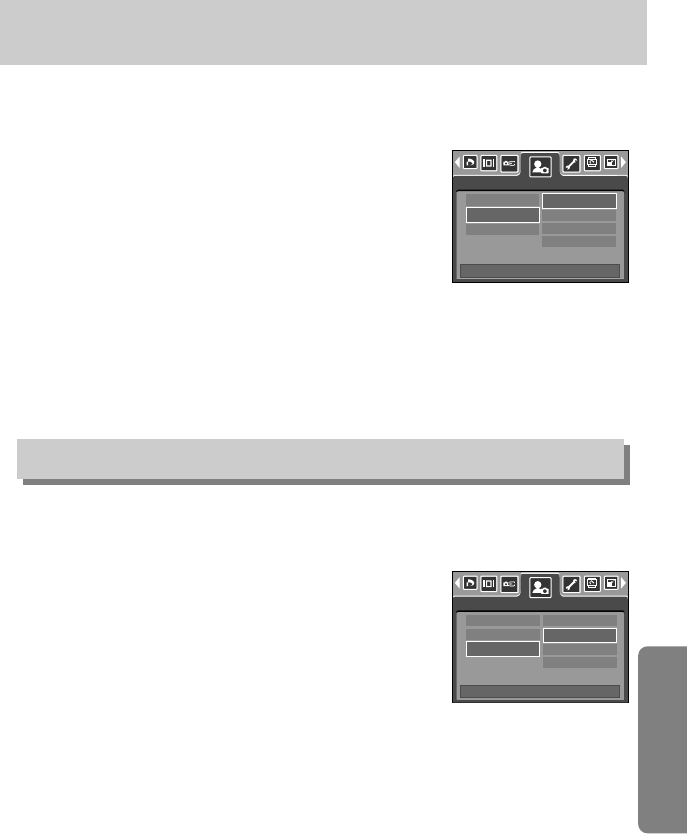
ŝ107Ş
Start up sound
Shutter sound
ƃSetting the Startup Sound
1. In any mode with the exception of Voice Recording mode,
press the MENU button.
2. Press the LEFT/ RIGHT button and select the [MYCAM]
menu tab.
3. Select the [S.SOUND] menu by pressing the UP/ DOWN
button and press the RIGHT button.
4. Select a desired sub menu by pressing the UP/ DOWN
button and press the OK button.
5. Press the menu button twice and the menu will disappear.
ƈYou can select the sound that is activated whenever the camera is turned on.
ƃSelecting the Shutter Sound
1. In any mode with the exception of Voice Recording mode,
press the MENU button.
2. Press the LEFT/ RIGHT button and select the [MYCAM]
menu tab.
3. Select the [SH.SOUND] menu by pressing the UP/
DOWN button and press the RIGHT button.
4. Select a desired sub menu by pressing the UP/ DOWN
button and press the OK button.
5. Press the menu button twice and the menu will disappear.
ƈYou can select the shutter sound.
S.IMAGE
S.SOUND
SH.SOUND
OFF
SOUND1
SOUND2
SOUND3
MYCAM
S.IMAGE
S.SOUND
SH.SOUND
OFF
SH.SOUND1
SH.SOUND2
SH.SOUND3
MYCAM
BACK:SET:OK
BACK:SET:OK

ŝ108Ş
Important notes
Be sure to observe the following precautions!
ƈThis unit contains precision electronic components. Do not use or store this unit in the
following locations.
- Areas exposed to severe changes in temperature and humidity.
- Areas exposed to dust and dirt.
- Areas exposed to direct sunlight or the inside of a vehicle in hot weather.
- Environments where there is high magnetism or excessive vibration.
- Areas with high explosives or highly flammable materials.
ƈDo not leave this camera in places subject to dust, chemicals (like naphthalene and mothball),
high temperature and high humidity.
Keep this camera with silica gel in a hermetically sealed box when not planning to use the
camera for a long period of time
ƈSand can be particularly troublesome to cameras.
- Do not let sand get inside the unit when using it on beaches, coastal dunes, or other areas
where there is lots of sand.
- Doing so may result in failure or may permanently render the unit unusable.
ƈHandling the camera
- Never drop the camera or subject it to severe shocks or vibrations.
- Prevent the large size LCD monitor from an impact. When this camera is not used, keep
this camera in the camera case.
- Avoid obstructing the lens or the flash when you capture an image.
- This camera is not waterproof.
To avoid dangerous electrical shocks, never hold or operate the camera with wet hands.
- If you use this camera in wet places, such as beach or pool, do not let water or sand get
inside the camera. Doing so may result in failure or may permanently damage the unit.
ƈExtremes in temperature may cause problems.
- If the camera is transferred from a cold to a warm and humid environment, condensation
can form on the delicate electronic circuitry. If this occurs, turn the camera off and wait for at
least 1 hour until all moisture is dispersed. Moisture build up can also occur in the memory
card. If this happens, turn off the camera and remove the memory card. Wait until the
moisture has dispersed.

ŝ109Ş
Important notes
ƈCaution on Using the Lens
- If the lens is subjected to direct sunlight, it could result in discoloration and deterioration of
the image sensor.
- Pay attention not to get fingerprints or foreign substances on the surface of the lens.
- When the lens cover opens, the outer lens that you can see is for auto focus. When using
or cleaning this camera, handle the outer lens with care.
ƈIf the digital camera is not used for a long period, an electric discharge can occur.
It is a good idea to remove the battery and the memory card if you do not intend using the
camera for an extended period of time.
ƈIf the camera is exposed to an electronic interference, it will turn itself off to protect the
memory card.
ƈCamera Maintenance
- Use a soft brush (available from photo stores) to gently clean the lens and LCD assemblies.
If this does not work, lens-cleaning paper with lens cleaning fluid can be used.
Clean the camera body with a soft cloth. Do not allow this camera to come into contact with
solvent materials such as benzol, insecticide, thinners etc. This may damage the body shell
of the camera and also affect its performance. Rough handling can damage the LCD
monitor. Take care to avoid damage and keep the camera in its protective carry case at all
times when not in use.
ƈDo not attempt to disassemble or modify the camera.
ƈUnder certain conditions, static electricity can cause the flash unit to fire. This is not harmful to
the camera and is not a malfunction.
ƈWhen images are uploaded or downloaded(when the charger and USB cable are inserted
into the cradle at the same time), the data transfer may be affected by static electricity.
In this case, disconnect and re-connect the USB cable before trying the transfer again.
ƈBefore an important event or going on a trip, you should check the camera condition.
- Take a picture for testing the camera condition and prepare extra battery.
- Samsung cannot be held responsible for camera malfunctions.
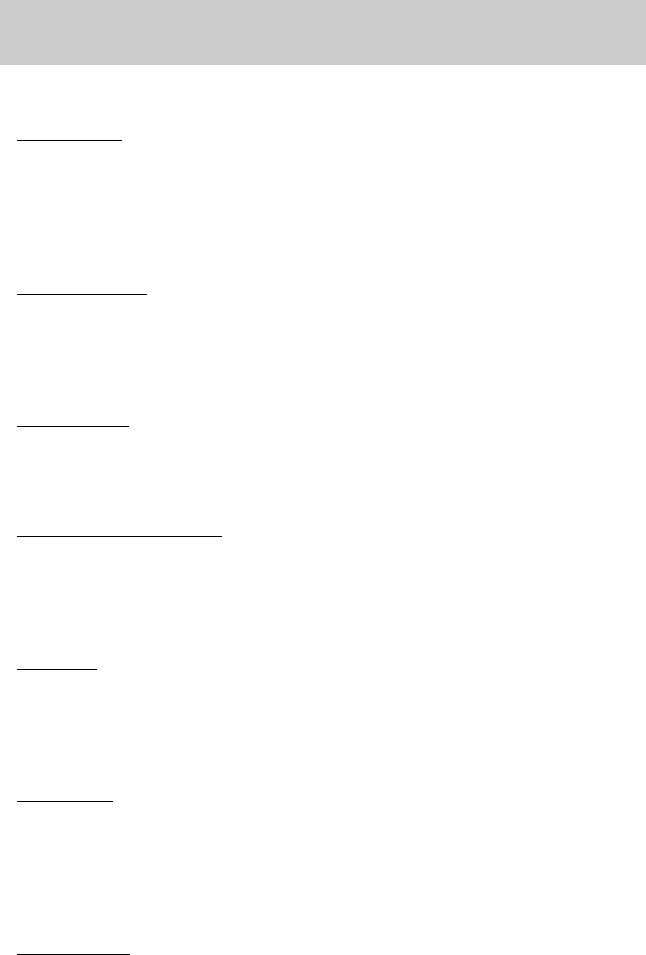
ŝ110Ş
Warning indicator
ƈThere are several warnings that may appear on the LCD display
CARD ERROR!
ϛMemory card error
ƍTurn off the camera power and turn it on again
ƍInsert the memory card again
ƍInsert the memory card and format the memory card (p.99)
MEMORY ERROR!
ϛInternal memory error
ƍTurn off the camera power and turn it on again
ƍFormat the memory with the memory card removed. (p.99)
CARD LOCKED!
ϛThe memory card is locked
ƍSD memory card : Slide the write protect switch to the top of the memory card
CARD FULL!/ MEMORY FULL!
ϛThere is insufficient memory capacity to take an image
ƍInsert a new memory card
ƍDelete unnecessary image files to free up some memory
NO IMAGE!
ϛThere are no images stored on the memory
ƍTake images
ƍInsert a memory card that is holding some images
FILE ERROR!
ϛFile error
ƍFormat the memory card
ϛMemory card error
ƍContact a camera service centre
LOW BATTERY!
ϛThere is low battery capacity
ƍInsert charged battery
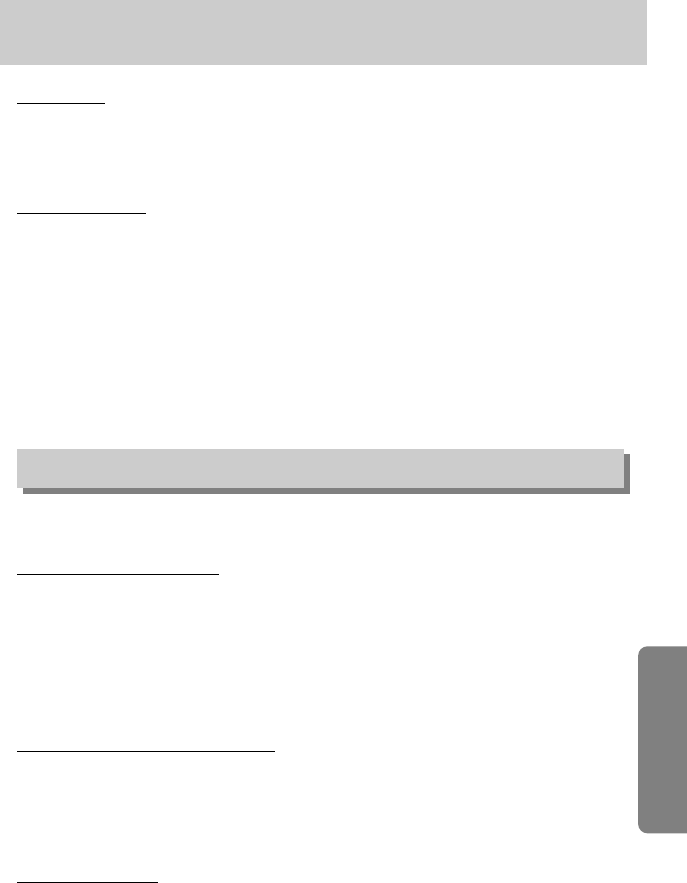
ŝ111Ş
Warning indicator
ƈPlease check the following
Before contacting a service centre
LOW LIGHT!
ϛWhen taking pictures in dark places
ƍTake pictures in Flash Photography mode.
OUT OF NUMBER
ϛWhen selecting too many printing pages in the PictBridge menu.
ƍSelect printing page within the limitation.
The camera doesn’t switch on
ϛThere is low battery capacity
ƍInsert charged battery (p.17)
ϛBattery are inserted incorrectly with the polarities reversed
ƍInsert the battery according to the polarity marks (+, -)
ϛThe rechargeable battery is not inserted
ƍInsert the battery and turn on the camera
The camera power ceases while in use
ϛThe battery are exhausted
ƍInsert charged battery
ϛThe Camera is turned off automatically
ƍTurn on the camera power again.
Battery drain quickly
ϛThe Camera is being used in low temperatures
ƍKeep the camera in warm conditions (i.e. inside a coat or jacket) and only remove it in
order to take images

ŝ112Ş
Before contacting a service centre
Camera does not take images when pressing the Shutter button
ϛThere is insufficient memory capacity
ƍDelete unnecessary image files
ϛThe memory card has not been formatted
ƍFormat the memory card (p.99)
ϛThe memory card is exhausted
ƍInsert a new memory card
ϛThe memory card is locked
ƍRefer to [CARD LOCKED!] error message (p.110)
ϛThe camera’s power is off
ƍTurn the camera power on
ϛThe battery are exhausted
ƍInsert charged battery.
ϛBattery is inserted incorrectly with the polarities reversed
ƍInsert the battery according to the polarity marks (+, -)
The camera suddenly stops working while in use
ϛThe camera was stopped due to a malfunction
ƍRemove /re-insert battery and switch the camera on
The images are unclear
ϛA picture was taken the subject without setting an appropriate macro mode
ƍSelect an appropriate macro mode to take a clear image.
ϛThe picture was taken with the subject beyond the flash range
ƍTake a picture within the flash range
ϛThe lens is smudged or dirty
ƍClean the lens
The flash does not fire
ϛFlash off mode has been selected
ƍDis-engage flash off mode
ϛThe camera mode can’t use the flash
ƍRefer to the FLASH instruction (p.37)
Incorrect date and time is displayed
ϛThe date and time have been set incorrectly or the camera has adopted the default settings
ƍReset the date and time correctly
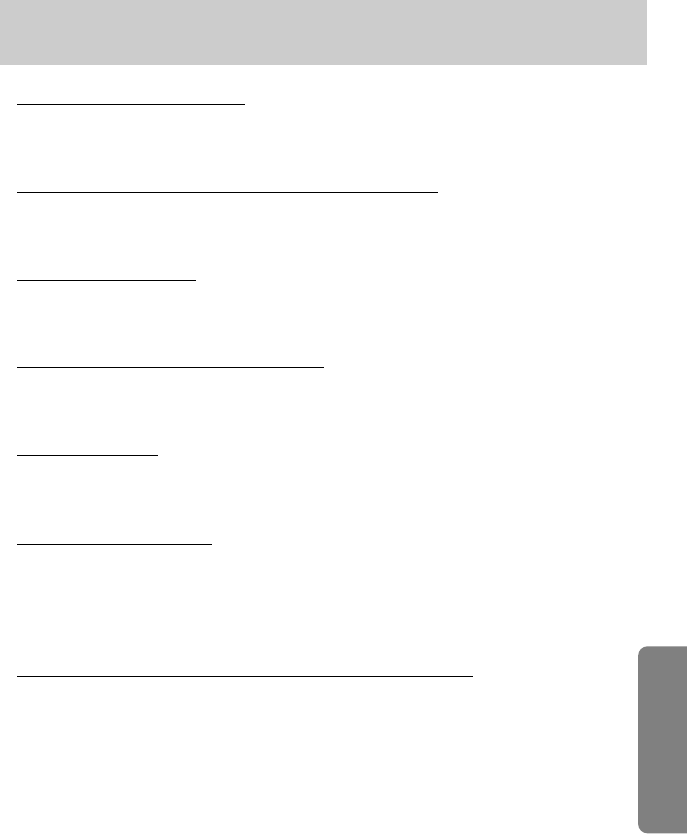
ŝ113Ş
Before contacting a service centre
The camera buttons do not operate
ϛCamera malfunction
ƍRemove /re-insert battery and switch the camera on
A card error has occurred while the memory card is in the camera.
ϛIncorrect memory card format
ƍRe-format the memory card
The images don't play back
ϛIncorrect file name (Violation of DCF format)
ƍDo not change the image file name
Colour of image is different to the original scene
ϛWhite balance or effect setting is incorrect
ƍSelect appropriate White balance and effect
Images are too bright
ϛExposure is excessive
ƍReset exposure compensation
No image on external monitor
ϛThe external monitor has not been connected properly with the camera
ƍCheck the connection cables
ϛThere are incorrect files in the memory card
ƍInsert a memory card that has correct files
When using the PC’s explorer, the [Removable Disk] file does not show
ϛCable connection is incorrect
ƍCheck the connection
ϛThe camera is off
ƍTurn the camera on
ϛThe operating system is not Windows 98, 98SE, 2000, ME, XP/ Mac OS 10.0 or later.
Alternatively the PC does not support USB
ƍInstall Windows 98, 98SE, 2000, ME, XP/ Mac OS 10.0 or later to PC that supports USB
ϛThe camera driver is not installed
ƍInstall a [USB Storage Driver]
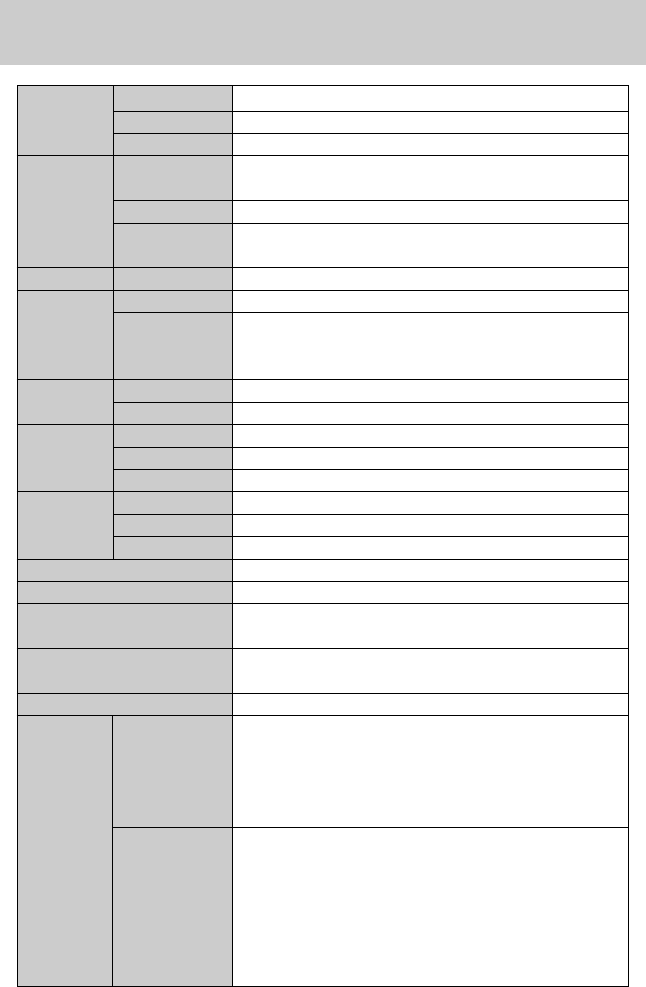
ŝ114Ş
Specifications
Type 1/2.5ůCCD
Effective Pixel Approx. 5.0 Mega-pixel
Total Pixel Approx. 5.2 Mega-pixel
SHD Lens f = 4.6 ~ 22.2mm
(35mm film equivalent : 28~135 mm)
Lens F No. F 3.3 ~ F 4.8
Still Image mode : 1.0X ~ 5.0X, Movie Clip mode : 1.0X ~ 2.0X
Play mode : 1.0X ~ 9.0X (depends on image size)
Viewfinder LCD Monitor 2.8" Wide color TFT LCD (195,840 dot)
Type TTL auto focus
Normal : 80cm ~ infinity
Macro : 2cm ~ 80cm (Wide), 14cm ~ 80cm (Tele)
Auto Macro : 5cm ~ infinity (Wide), 14cm ~ infinity (Tele)
Type Mechanical and Electronic shutter
Speed 1 ~ 1/2,000 sec. (Night Scene mode : 16 ~ 1/2,000 sec.)
Control Program AE Metering : Multi, Center-weighted, Spot
Compensation ±2EV (1/3EV steps)
ISO Equivalent Auto, 50, 100, 200, 400
Modes Auto, Auto & Red-eye reduction, Fill-in, Slow sync, Off
Flash Range Wide : 0.3m~ 3.0m, Tele : 0.3m~ 2.0m
Recharging Time Approx. 5 sec.
Sharpness Soft, Normal, Vivid
Effect Normal, B&W, Sepia, Red, Green, Blue, Negative, RGB
Auto, Daylight, Cloudy, Fluorescent_H, Fluorescent_L,
Tungsten, Custom
Voice Recording (max. 1 hour)
Voice Memo in Still Image (max. 10 sec.)
Date Imprinting Off, Date, Date&Time (user selectable)
Modes : Auto, Program, Scene
* Scene : Night, Portrait, Children, Landscape, Text, Close-up,
Sunset, Dawn, Backlight, Fireworks, Beach & Snow
Continuous : Single, Continuous, AEB
Self-timer : 2 sec., 10 sec., Double (10sec. & 2sec.), Remote control (optional)
With audio (recording time : memory capacity dependent)
Size : Wide 640x360, 384x218,256x144
STD 640x480, 320x240, 160x120
Frame rate : 30 fps, 15 fps Movie Stabiliser (user selectable)
Movie Editing (embedded) : Pause during recording, Still Image capture,
Time Trimming
Focal Length
Digital Zoom
Focusing
Image Sensor
Exposure
Range
Shutter
White Balance
Voice Recording
Shooting
Still Image
Movie Clip
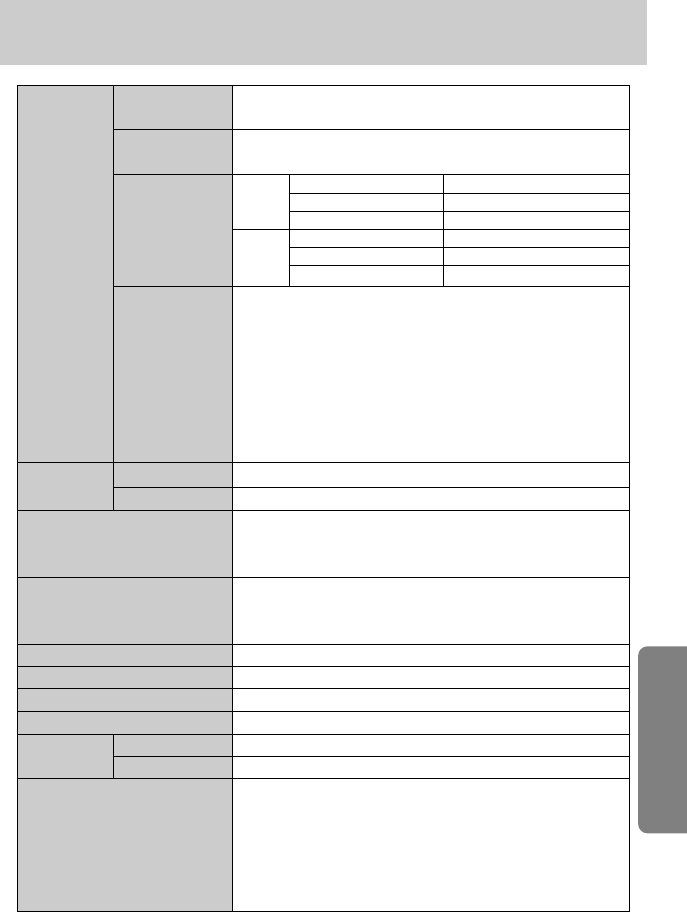
ŝ115Ş
Specifications
Internal memory : Approx. 24MB flash memory
External memory : SD Card/MMC (Up to 1GB guaranteed)
Still Image : JPEG (DCF), EXIF 2.2, DPOF 1.1, PictBridge 1.0
Movie Clip : MP4 (MPEG-4) Audio : WAV
5M : TIFF 1, SUPER FINE 9, FINE 18, NORMAL 27
4M : TIFF 2, SUPER FINE 12, FINE 23, NORMAL 34
3M : TIFF 2, SUPER FINE 14, FINE 28, NORMAL 41
2M : TIFF 4, SUPER FINE 23, FINE 45, NORMAL 64
1M : TIFF 10, SUPER FINE 47, FINE 74, NORMAL 106
VGA : TIFF 24, SUPER FINE 99, FINE 148, NORMAL 185
*
These figures are measured under Samsung’s standard conditions and
may vary depending on shooting conditions and camera settings.
Type Single image, Thumbnails, Slide show, Movie Clip, Album
Editing Trimming, Resizing, Rotating, Effect
Digital output connector : USB 2.0 Audio : Mono
Video output : NTSC, PAL (user selectable)
DC power input connector : 4.2V
Rechargeable battery : 3.7V Li-ion battery (SLB-1237)
AC Charger : DC 4.2V, 750mA (SAC-41)
*
Included power source may vary depending on sales region.
Dimensions (WxHxD)
99 x 55 x 27mm (excluding the projecting parts of the camera)
Weight 169g (without battery and card)
Operating Temperature 0 ~ 40ŭC
Operating Humidity 5 ~ 85%
Camera Driver
Storage Driver (Windows98/98SE/2000/ME/XP, Mac OS 10.0 or later)
Digimax Master, Digimax Reader, QuickTime Player
5.0 Mega-pixel, 28mm wide-angle and optical 4.8X telephoto zoom
The world’s first*12.8” Wide TMR LCD
The fast response – Booting 1.3 sec, Shot-to-shot 1.0 sec.
Elegant design with full metal cover
Easy Charging System
ſSpecifications are subject to change without prior notice.
ſAll trademarks are the property of their respective owners.
* 1 : Among digital cameras , introduced by August of 2005.
Capacity
(24MB)
Storage
Interface
Image Play
Power Source
Software
Special Features
Application
Media
File Format
Image Size
5"!` 5" `
5"`! 5"!`
5" ` >/)" `
5"!`! 5"`
5" ` 5"`
5"` >/)"`
?QLM
;<,
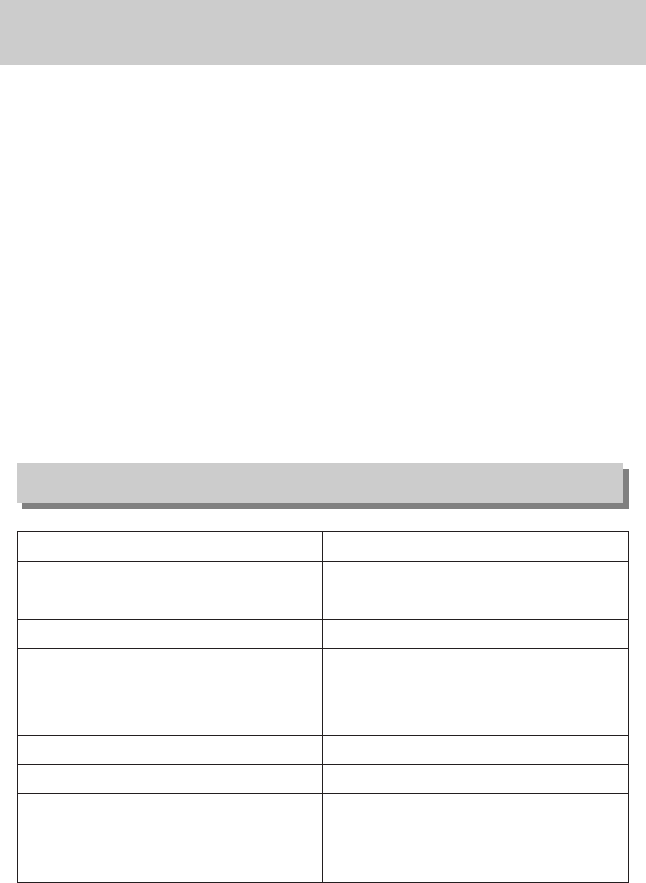
ŝ116Ş
Please ensure that you read the instruction manual carefully before use.
ϛThe attached software is a camera driver and image editing software tool for Windows.
ϛUnder no circumstances should all or part of either the software or the user manual be
reproduced.
ϛCopyrights for software are licensed only for use with a camera.
ϛIn the unlikely event of a manufacturing fault, we will repair or exchange your camera.
We cannot, however, be held responsible in any way for damage caused by inappropriate use.
ϛUsing a Hand-made PC or a PC and OS that has not been guaranteed by the manufacturer
is not covered by the Samsung warranty.
ϛBefore reading this manual, you should have a basic knowledge of computers and O/S
(Operating Systems).
System Requirements
Software Notes
For Windows For Macintosh
Power Mac G3 or later
Windows 98/98SE/2000/ME/XP Mac OS 10.0 or later
Minimum 64MB RAM (XP : 128MB) Minimum 64MB RAM
200MB of available hard disk space 110MB of available hard-disk space
(1GB recommended)
USB port USB port
CD-ROM drive CD-ROM drive
QuickTime player
PC with processor better than Pentium II
450Mz (Pentium 700MHz recommended)
1024x768 pixels, 16-bit colour display
compatible monitor (24-bit colour display
recommended)
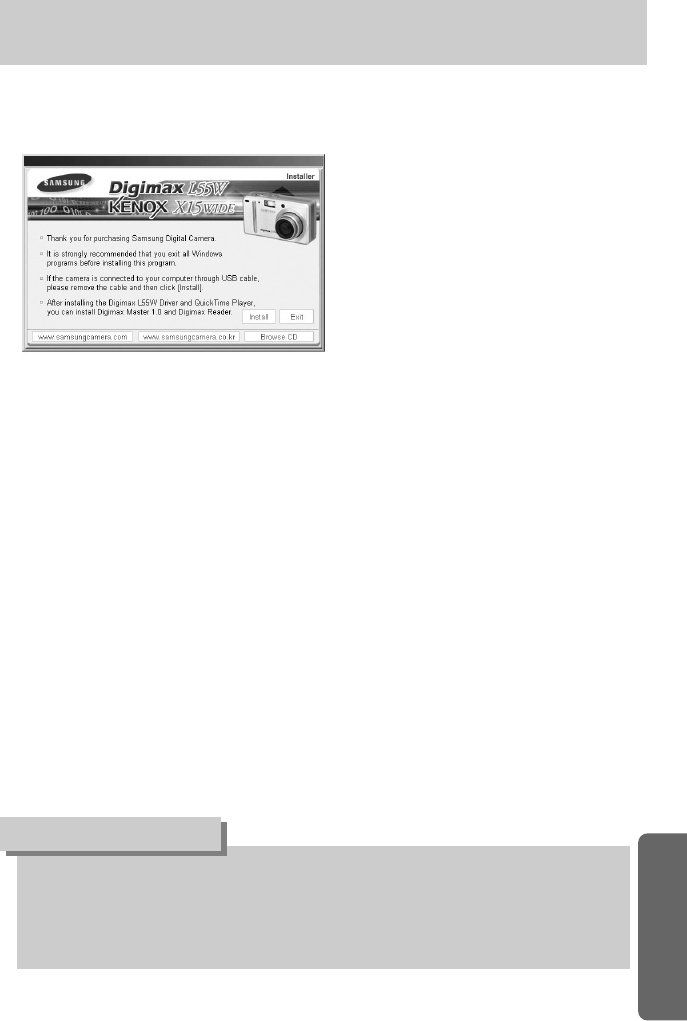
After inserting the software CD provided with this camera into the CD-ROM drive, the following
window should automatically run.
Before connecting the camera to the PC,
you should first install the camera driver.
ƈCamera driver : This enables images to transfer between the camera and PC.
This camera uses the USB Storage Driver as the camera driver. You can use the camera as
a USB card reader. After installing the driver and connecting this camera to the PC, you can
find [Removable Disk] in [Windows Explorer] or [My computer]. A USB Storage Driver is
provided only for Windows. A USB Driver for MAC is not included with the Application CD.
You can use the camera with Mac OS 10.0 or later.
ƈQuickTime Player : The program for playing back QuickTime movies (.MP4). It can also
play video files compressed with MPEG4 codec.
ƈDigimax Master : This is the all-in-on multi media software solution
You can download, view, edit and save your digital images and movie clips with this
software. This software is only compatible with Windows.
ƈDigimax Reader : Text recognition program
You can save an image file that was captured in the TEXT mode as a text file with this
program. This software is only compatible with Windows.
ƃBe sure to check the system requirements before installing the driver.
ƃYou should allow 5~10 seconds for running the automatic setup program according to the
capability of your computer. If the frame does not show, run the [Windows Explorer] and
select [Samsung.exe] in the CD-ROM Drive root directory.
INFORMATION
ŝ117Ş
About the software
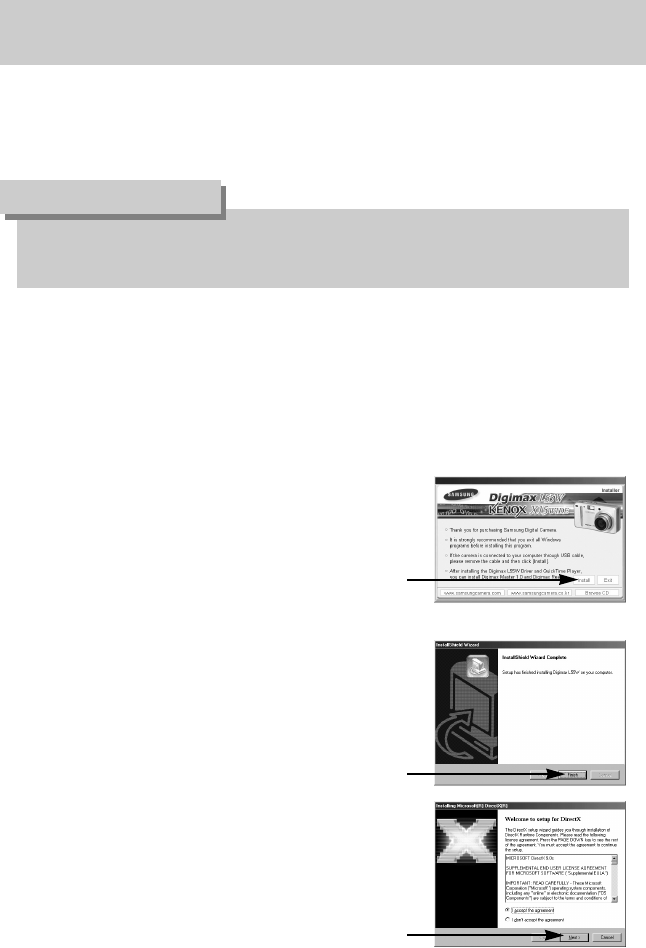
ŝ118Ş
To use this camera with a PC, install the application software first.
After this has been done, the stored images in the camera can be moved to the PC and can be
edited by an image editing program.
You can visit the Samsung web-site through the internet.
http://www.samsungcamera.com : English
http://www.samsungcamera.co.kr : Korean
1. Click the [Install] menu in the Auto run frame.
The camera driver is installed automatically.
ƃClose other programs before installing the application software.
ƃBefore installing the application software, disconnect the USB connection.
INFORMATION
2. Installation is complete.
Click the [Finish] button.
[Click !]
[Click !]
3.
The Software License Agreement window for
DirectX will be displayed.
If you agree to this, select [I accept the agreement]
and click [Next >] button. the window will then
move to the next step. If you disagree, select
[I do not accept the agreement] and click [Cancel]
button.
The installation program will be cancelled.
[Click !]
Setting up the application software
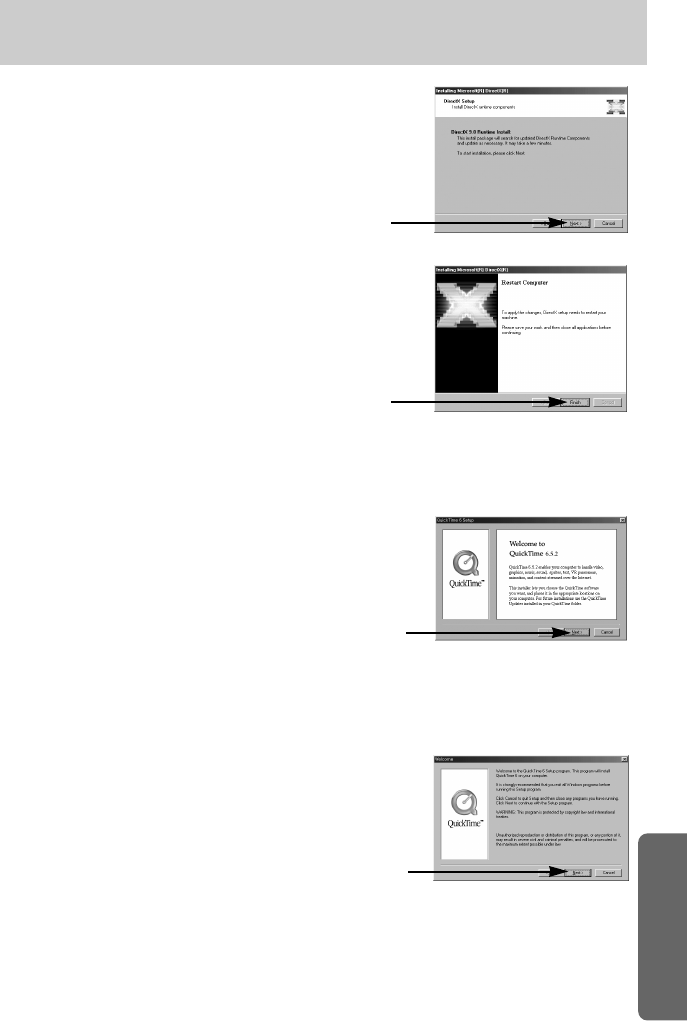
4. A window will open. Click the [Next(N) >] button.
5. DirectX Installation is completed.
Click the [Finish] button and then the
QuickTime installation will be started.
* The system will not reboot even if you click
the [Finish] button.
* The screen shot of step 5 can be different
from the illustration depending on the
system requirements.
[ቄඁ!]
[Click !]
Setting up the application software
7. A Welcome window will appear.
Click [Next >] to proceed to the next screen.
[Click !]
6. Click [Next >] to begin installing QuickTime.
[Click !]
ŝ119Ş
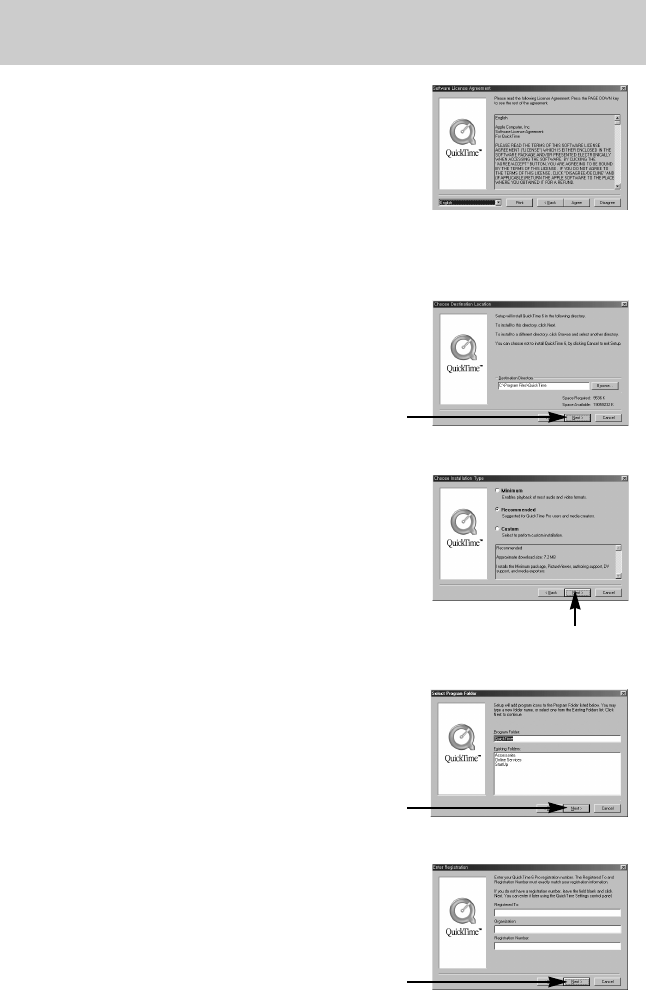
ŝ120Ş
Setting up the application software
8. The Software License Agreement window will open, asking
you to agree to the licensing. Use the button on the bottom
left to select the language of your choice, and then click
[Agree] to accept the license agreement. The installation
will proceed to the next stage. If you do not agree to the
license agreement, click [Disagree]. The installation will be
canceled. If the language of your choice is not listed, please
select [English].
9. A window will open, asking you to select a destination
folder where the files will be copied to. Click [Next >].
To copy the files to another folder, click [Browse..] Browse
to a folder you want to copy the files to.
10. The Choose Installation Type window will open.
Click [Next >].
[Minimum] : Installs required files only.
[Recommended] : Installs required files and the most
commonly used optional files.
[Custom] : Allows you to install only the components you
choose.
11. A window will open, asking you to choose a folder to
which program icons will be added. Click [Next >].
If you want to add the program icons to a different folder,
choose another folder, and then click [Next >].
[Click !]
[Click !]
[Click !]
12. The Enter Registration window appears.
Enter your name and organization in the respective fields,
and then click [Next >].
You do not have to enter a registration number.
[Click !]